
Navigation Lights for Sailboats (And How To Read Them)

Last Updated by
Capt Chris German
June 15, 2022
Navigation lights on a sailboat can be confusing. If you understand the reason behind why they are the way they are however, they can make a lot more sense.
At their heart, sailboats are really just a power boat and as such must adhere to all power boat rules such as navigation lights. Other times however, a sailboat is classified in a special category. They have a set of additional lights they CAN show as an option, but are not always required to do so.
That’s about as clear as mud if you ask me and I contend that that is where the confusion about lighting a sailboat begins.
Just because you can show a light to identify yourself in times of low visibility, does not mean you have to and then we add in a little sibling rivalry between power and sail and things get downright adversarial when it comes to navigation and the night.
Table of contents

The USCG says You’re a Power Boat Whether You Like It or Not
Much to the consternation of many a sailor who has earned a commercial license to drive their sailboat, when you received your credential from the USCG it says you are a master of steam and power across the top with no mention of wind as a source of propulsion.
It is not until you read the back pages of your little red book that feels like a passport and looks like a US Sailing credential, that you will see the term “sail auxiliary”. That is because most of the time the U.S. Coast Guard knows that you are primarily reliant on your mechanical power to propel your vessel.
It's a sad thing, but the days of commercially viable sail boats are done and all but the most select few even have sails let alone use them as their primary power source. All sail boats by law are powerboats, but not all powerboats are sailboats.
Navigation Lights for a Power Boat
As a power boat, you are required to show certain lights and have been required to do so before power was even invented.
In the days of man powered vessels like the viking ships who relied on oars while in close quarters to power their vessels, they needed to show other boats, friend or foe, where they were by showing lanterns in the dark to identify themselves. As you know, it is a time honored rule among all the nations of the world both past and present, that you must avoid a collision at all costs while at sea and even the viking knew that you should not run into things.
By lighting the front and back of your boat, you could warn other boats of your presence as well as identify which way you were heading. As such there is a very specific rule in the Code of Federal Regulations Number 46 (CFR46 by common name) that spells out with detail how many, the color, the luminosity or brightness, the angle of visibility and the location of all of the lights required for navigation on every single boat, seaplane, submarine and other nondescript vessel conceived by man to date that they must show while underway in reduced visibility.
And there is no flexibility in the rules.
As such a power boat, and by extension all sailboats, MUST, without question show one green light on the starboard bow and one red light on the port bow and one all around white light or lights while operating in reduced visibility. These lights should shine at all 360 degrees of visibility with the bow lights shining at an angle of dead ahead to 22.5 degrees abaft the beam and the stern lights shining 225 degrees dead aft. A forward facing masthead light that is white in color shall shine forward to comply with the directive that all vessels must carry an all around white light. For more read here .
As you can see, there isn’t much wiggle room when it comes to lights that must be shown.
Sailboats get a little flexibility with lights
Sailboats however, are a little different when they are in fact sailboats, which is only when you are entirely reliant on the wind for power and in no way reliant on any mechanical or manual means of propulsion. And for good reason.
Back in the day when men were men and sailboats were wooden, fire was a major concern. Sails were coated with wax and other flammable substances and the wood on boats was saturated with oils and grease. Even the ropes were plant materials saturated with oils to keep them pliable and strong.
Add those highly flammable substances to a parching environment like the sea and you had what was essentially a giant floating tinderbox.
Then tell that giant floating tinderbox that they need to identify themselves to the world at large at night using oil lamps with flames because batteries and lights were not invented yet. It didn't take very long or very many ships burning to the water line for the Governments to say to the sailboats, you get to do things a little different.
As such, sailboats are given special dispensation when it comes to lights aloft. They don't have to show an all around white light in their rigging because no one wanted to set their rig on fire with oil lamps 60 feet up in their rig.
However, when a sailboat takes their sails down such as when they are powered or at anchor, they must resume the display of an all around white light or lights aloft. That became a real challenge with aluminum masts and the disappearance of rat lines on the shrouds because there was no easy way to climb the rig and check the bulbs up the mast on a regular basis.
Red over Green Sailing Machine
I have no idea where the history of this particular light comes from, but if you ever take a deck exam with the USCG, you better remember this mnemonic. An all around red light over an all around green may be displayed on a vessel during times of reduced visibility to indicate that a vessel is operating under sail power alone.
I won’t even speculate on how or why they came up with this particular light configuration, but if you want to use these lights as a sailing vessel, you can do so, but that means that you will need three all round lights at the top of your mast, an all around white, an all around red and an all around green, just in that order.
The red over green is to be displayed in addition to the running lights or the red and green bow lights with the 225 degree stern light. As always, when the motor comes on, so does the steaming light or the forward facing white light that is also usually about ¾ of the way up on your mast to complete the requirement of an all around white light that indicates a power vessel.
What is a “steaming light” and why are you mentioning it now?
Most sailboat electrical panels will have a switch that is labelled “steaming light” and it will only come on when your anchor light is off. This is probably the most confusing part of sailboat navigation lights so if you are confused about this, you're in good company as most people are.
A “steaming” light is named thusly, going back to the days of steam powered sailboats where when they fired up their boilers and doused the sails, they became a power boat once again. There aren’t too many steam powered boats, let alone steam powered sailboats, but the name stuck and it is a vestige of a bygone era.
Either way, when you fire up your motor, you turn on your “steaming light” and that locks out the all around white light which is used for anchoring to minimize the number of switches on your panel and reduce the number of wires in your mast. The fewer wires, the less chance of something not working or becoming disconnected.
The steaming light and the anchor light both go up the mast, but you can’t use an all around white light while using the 225 degree stern light at the deck level because to other boaters you would look like you have two white lights from the stern and that would be confusing.
The anchor light is used exclusively for anchoring while the steaming light is used to indicate you are a power vessel while underway.
As to why I am mentioning it now in the article, is because this would have blown your mind if I started with this subject cause it can be really confusing stuff.
Aspect Recognition with Lights
Remember when I said earlier that lights can help you tell others which way you are heading as well as tell you which way other boats are heading? That is called the aspect of the vessel and the USCG tests you on this for your deck exam as well.
Knowing that the bow lights go 22.5 degrees abaft the beam on both sides or 112.5 degrees on each side, and the stern light faces 225 degrees aft for a total of 360 degrees of visibility, you can tell a lot about where a boat is heading and who has the right of way.
One thing that's easy to remember is red means stop and if you see a vessel's red light, it means stop as you are the give way vessel and approaching the other vessel from his port side. Conversely it works with green as well as that means you are approaching from the other vessel's starboard side and you are the standon vessel.
If you see a red and green light equally low on the horizon, that means your heading dead on into another vessel's path and conversely if all you see is a white light low on the horizon, it means you are overtaking another vessel power or sail, we don’t care because it is an overtaking situation. However, any time you do see a white light aloft in addition to the red and green bow lights, you know you are encountering a power boat.
Then there are angular approaches as well, where you see white and red or white and green light low on the horizon. You know in that case you are seeing a portion of the bow lights and stern lights from the side approaches of a vessel. Based on which direction those lights are heading, you can deduce which way that boat is going in relation to your boat.
So put it all together and you see a green light and a white light low on the horizon with a red over green light aloft, you know that you are approaching a sailboat that is traveling to your port and that might make you the standon vessel. That is of course, if we didn’t concern ourselves with windward and leeward and port tacks and starboard tacks, but that is a discussion for another article. So stay tuned when we talk about sailing rules and the right of way. But for now, do good, have fun and sail far.
Related Articles
Capt Chris German is a life long sailor and licensed captain who has taught thousands to sail over the last 20 years. In 2007, he founded a US Sailing-based community sailing school in Bridgeport, CT for inner city youth and families. When Hurricane Sandy forced him to abandon those efforts, he moved to North Carolina where he set out to share this love for broadcasting and sailing with a growing web-based television audience through The Charted Life Television Network.
by this author

Most Recent

What Does "Sailing By The Lee" Mean?
Daniel Wade
October 3, 2023

The Best Sailing Schools And Programs: Reviews & Ratings
September 26, 2023
Important Legal Info
Lifeofsailing.com is a participant in the Amazon Services LLC Associates Program, an affiliate advertising program designed to provide a means for sites to earn advertising fees by advertising and linking to Amazon. This site also participates in other affiliate programs and is compensated for referring traffic and business to these companies.
Similar Posts

How To Choose The Right Sailing Instructor
August 16, 2023

Cost To Sail Around The World
May 16, 2023

How To Drive A Pontoon Boat
Jacob Collier
December 19, 2022
Popular Posts

Best Liveaboard Catamaran Sailboats
December 28, 2023

Can a Novice Sail Around the World?
Elizabeth O'Malley

4 Best Electric Outboard Motors

How Long Did It Take The Vikings To Sail To England?

10 Best Sailboat Brands (And Why)
December 20, 2023

7 Best Places To Liveaboard A Sailboat
Get the best sailing content.
Top Rated Posts
Lifeofsailing.com is a participant in the Amazon Services LLC Associates Program, an affiliate advertising program designed to provide a means for sites to earn advertising fees by advertising and linking to Amazon. This site also participates in other affiliate programs and is compensated for referring traffic and business to these companies. (866) 342-SAIL
© 2024 Life of Sailing Email: [email protected] Address: 11816 Inwood Rd #3024 Dallas, TX 75244 Disclaimer Privacy Policy
Boat Navigation Lights Rules: Illustrated Beginners Guide
When navigating at night, the lights on other boats are your first clue about the moving dangers around you. And your navigation lights are your first line of safety in avoiding collisions in the dark, and they tell others vessels what you are and what you are doing. The rules sound complex, but with a little understanding you can get the basics for any situation.
So what are the basic navigation light rules? For most small vessels, motoring requires red and green (port and starboard) lights, and a white light visible in all directions around the boat. This is almost always a stern light and a masthead light on sailboats. Boats under sail require port and starboard lights, and a white stern light. Sailboats below sixty-five feet may show a tricolor light at the masthead instead of side and stern lights when sailing.
That's it, in a nutshell. There's a little more to it, as the rules change with different sizes and there are some specifics about angles of display for the colors. Identifying other ships at sea requires more study, but the basics are the same. And it's not much trouble to make sure you've always got the proper lights on your vessel.
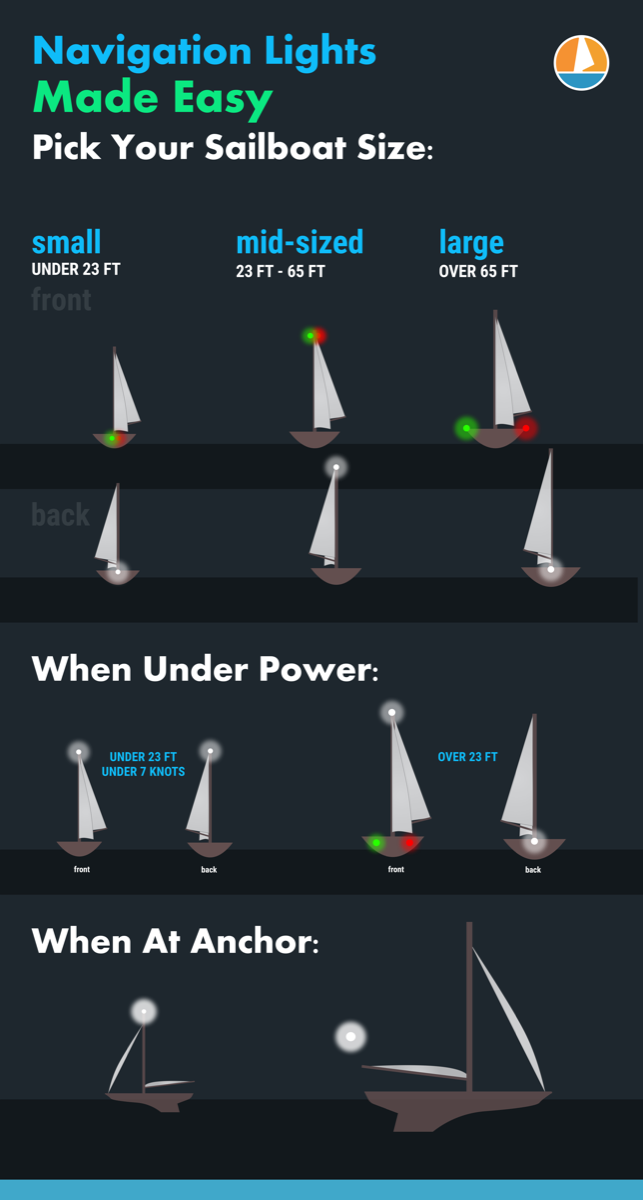
On this page:
What are the official colregs rules for your sailboat, what about the uscg (united states coast guard) rules, lighting at anchor, identifying the boats around you.
The International Regulations for the Prevention of Collision at Sea , abbreviated "COLREGS" is very specific about the lights required, their shapes and sizes, and the distance they must be visible. For the smaller boat, the following definitions apply.
- Masthead Light - a white light placed centerline on the boat showing an arc of 225 degrees with 112.5 degrees either side of the front of the vessel.
- Sidelights - A red light on the port side and a green light on the starboard. They must show an arc of 112.5 degrees from centerline of the bow.
- Stern light - A white light on the stern of the boat showing an unbroken arc of 135 degrees from centerline of the vessel.
- All-round light - A light showing in an unbroken arc of 360 degrees.
The good news is you need not measure these angles. Any properly installed USCG or COLREGS approved light which will cover the correct arcs. If you have to replace the original light from your boat, make sure it's with an approved replacement.
Lights When Sailing
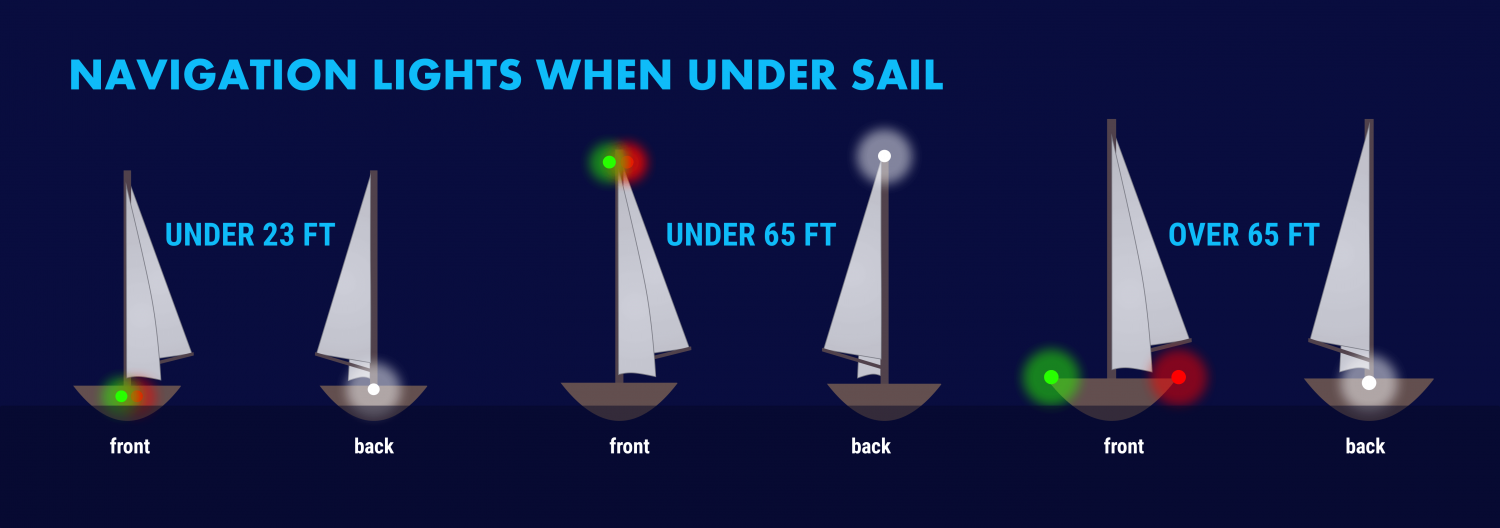
The specific rules for a sailboat under sail are in COLREGS Rule 25 and vary slightly with the size of the boat. A sailboat powering is considered a power boat and falls under in Rule 23.
- Under 23 feet (7 meters) - side lights and a stern light, possible. If these lights can not be displayed a light must be kept at hand to help avoid a collision. This can be a bright flashlight.
- Over 23 feet - Side lights visible to one nautical mile and stern light visible for two.
- Vessels under 65 feet may combine both sidelights into a single lantern on the bow.
- May show a tricolor light on the masthead instead of sidelights and a stern light. It's one or the other though, do not show these lights at the same time .
- Masthead light must be visible for three nautical miles, all other lights must have a two nautical mile visibility.
- Side lights must be separated.
- May not show a masthead tricolor light.
- Masthead light must have five nautical mile visibility, all other lights must be visible for two nautical miles.
- Optional masthead lights - any vessel under sail may display a red light over a green light at the masthead with sidelights and stern light. The red over green may NOT be displayed with a masthead tricolor light. It's one set or the other.
Lights When Motoring
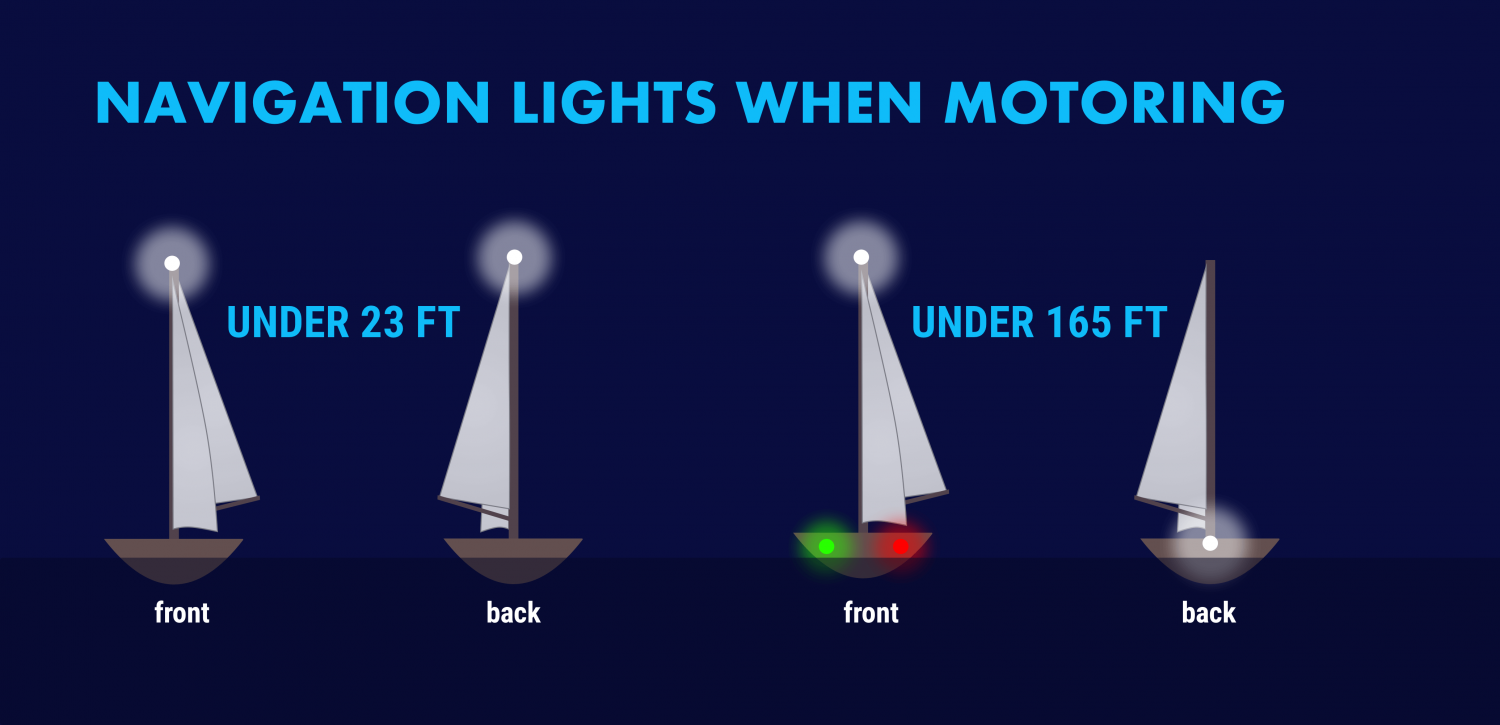
For all navigational purposes a sailboat under power is considered a power boat. This includes motor sailing - if the engine is on and providing propulsion you are on a power boat, even if the sails are up . This applies to navigation lighting, sound signals in fog and limited visibility, and rights of way.
Sailboats under 50 meters under power need to show:
- A masthead light
- Stern light
A power-driven vessel under 23 feet (7 meters) that does not exceed seven knots of speed may display an all around white light, though sidelights should be used if available.

The USCG has published its own "Rules of the Road" that are based on the COLREGS. In addition, it has rules for the "Inland Waterways" for rivers, inland lakes and the Great Lakes.
The good news is this has no impact on what you have to do with your own boat.
They mostly relate to lighting changes on towed vessels like barges and tugs. For example, a vessel towing or pushing another vessel in the ocean under COLREGS shows two masthead lights, sidelights and a stern light, whereas in Inland Waterways the towing or pushing vessel displays two yellow towing lights instead of a white stern light.
If you sail on lakes, rivers or the Great Lakes where towed commercial traffic is common you should learn the inland lights, but coastal or ocean sailors will never see these.
When you anchor outside a designated mooring field, you should display an all around white light at the masthead or as high in the boat as practical.
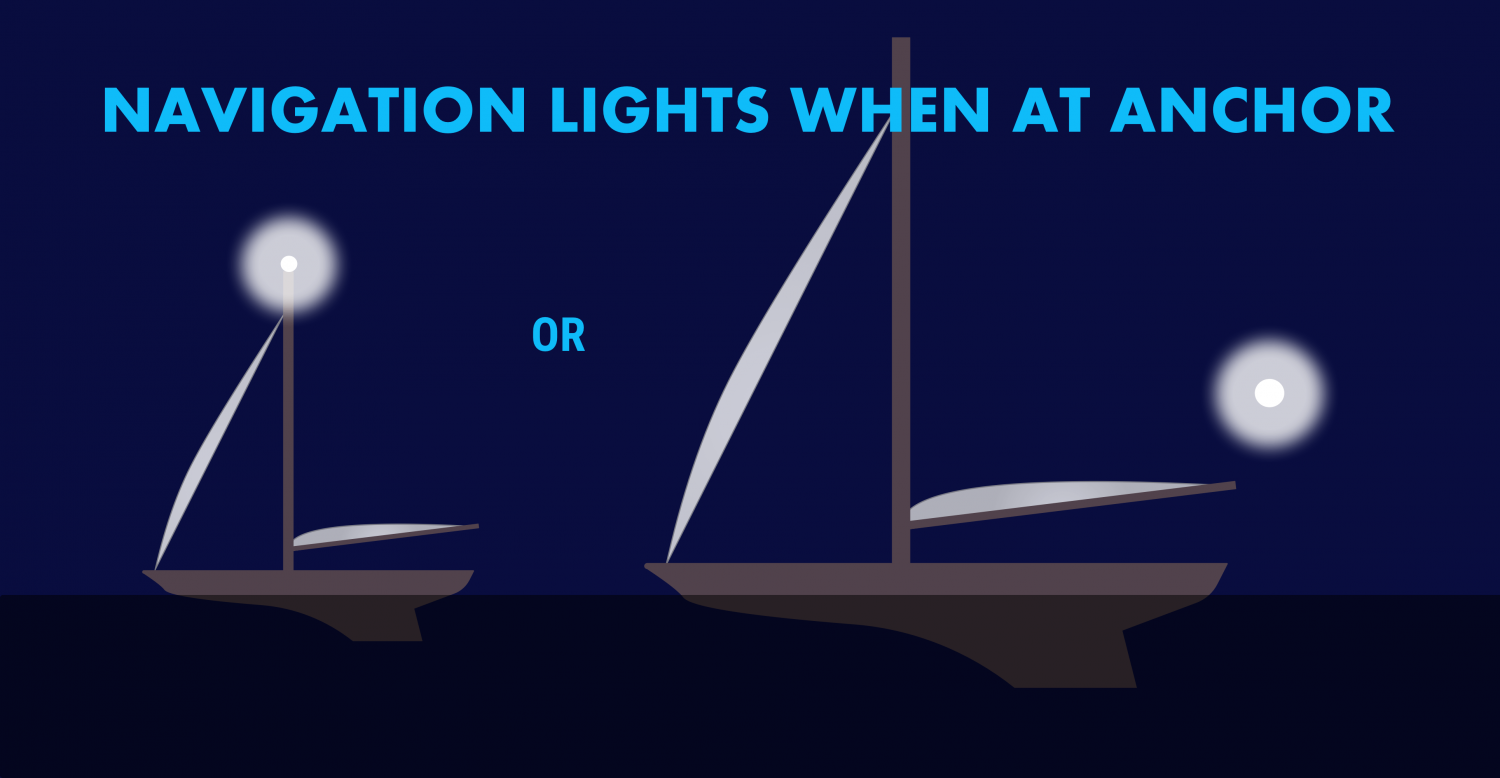
If your boat is large and has a very tall mast, you may wish to display another light closer to the waterline. Boats approaching in the dark may not see a light on a mast sixty or seventy feet in the air when they are close to your boat.
We use a simple garden path light on our stern when we anchor, left in a rod holder or flag socket. It comes on automatically at dusk and is a cheap and easy way to be more visible. There is no specific rule stating you can not display more lights than required, or the nature of any lights beyond the required all around light.
The COLREGS also specify that a round black "daymark" should be displayed in the rigging of any vessel at anchor. Very few small vessels observe this, however it is the correct display for a vessel in an anchorage.
If you tie to a mooring in a marked mooring area you are not required to display anchor lights, but there is no harm in doing so.
The other important reason to know your lights is to figure out what's going on around you at night. The water may be ablaze with white, red, green and other lights at night and they are your first key to avoiding collisions and problems.
All combinations of lights for fishing boats, commercial vessels, and so on are outside this post‘s scope. The odds are small you will encounter a submarine, seaplane or hovercraft at night, but there are regulations regarding specific lighting for each of those vessels!
There are a few fundamentals to help you figure out what that is you see on the horizon, which way it is going, and whether it is a danger to you.
Port Wine is Red
The fundamental rule is that red sidelights will ALWAYS be on the port side of a vessel, and green lights will always be on starboard. However, some vessels can use all around red and green lights for other purposes, though those will be higher than sidelights.

The light‘s on a ship is not important, some large tankers and freighters will have their sidelights far aft and put them on the superstructure for better visibility. It is not safe to assume that sidelights you can see are on the bow of large vessels .
When you can see the color, you know which way the bow is pointing. If it's red, it's pointing more or less to the left and will travel in that direction. A green light shows it is heading more or less to your right.
If you can see the red and green lights at the same time, you are looking directly at the bow of the vessel. When you are far away, this isn‘t as alarming as if you are close crossing. Seeing red and green lights together on a vessel is something you never want to see for long.
Be aware of red and green lights used in combination with other red, green and white lights. These may not be running lights and could have other significance.
Tankers, Freighters and Large Ships
Tankers, freighters and large ships will have side lights, a stern light and a masthead light. In addition, on vessels over 50 meters there will be a second masthead light further aft and higher than the forward light. The masthead light positions are a better tipoff to the bow direction and how far from the bow the sidelights might be. Remember - on a large vessel the sidelights may not be at the bow or even close to it.
USCG Inland Rules allow for a second all-around white light on large vessels on the Great Lakes instead of a second masthead light.
Fishing Boats
Fishing boats engaged in fishing will have more complex light displays. When they aren't fishing, they will show lights like any power vessel, but Rule 26 spells out light combinations that vary by the fishing activity being done. In general:
- Boats which are Trawling but not making headway will display a green all-around light over a white all-around light , and a masthead light aft of these lights. Boats making headway while trawling will show these lights, plus sidelights and a stern light.
- A vessel fishing other than trawling will show a red all-around light over a white all-around light . When making way they will also show sidelights and a stern light.
- If a vessel has gear more than 150 meters away from the boat, it will show a second all around light in the direction of the gear. The best rule is to give fishing boats as wide a berth as you can at night. They're easy to pick out if you check the top light configurations but their course may be difficult to predict.
Towing and Pushing
Towed vessels can be the most dangerous to cross, but they have the most lights to tell you what is happening. Refer to COLREGS or the USCG Rules of the Road Rule 24 for all combinations You can pick a tow/push vessel out with the following lights:
- Two or three masthead lights in a vertical line. Three masthead lights shows a tow over 200 meters. Additional masthead lights may show for larger tow vessels.
- A towing light (yellow light with the same characteristics as a stern light) directly above the stern light.
- The will also have side lights and a stern light.
- The towed vessel will show sidelights and a stern light. Lighting may vary under USCG inland rules, where towing lights may replace stern lights. Learn these differences if this is your regular cruising ground. If you think there is a tow ahead of you, always go well behind the aft most set of lights. Never go between a tow and avoid crossing ahead if possible as it may restrict their maneuverability.
Special Situations
There are several rare situations you may encounter. As a general rule, if there are a lot of lights and you don't understand them look for the sidelights on a moving vessel. If you can find them and figure out the direction it is moving, it makes the vessel easier to avoid. Stay well clear of lights you do not understand if you can avoid them without risk.
Most of these signals are used by larger, commercial vessels and you will not need them.
They use these light combinations with other light combinations. For example a towing vessel may also be restricted in maneuverability, and a vessel constrained by draft will show running lights if moving.
- Not Under Command - two all around red lights in a single line
- Restricted in Ability to Maneuver - red, white then red in a single line
- Constrained by draft - three all around red lights
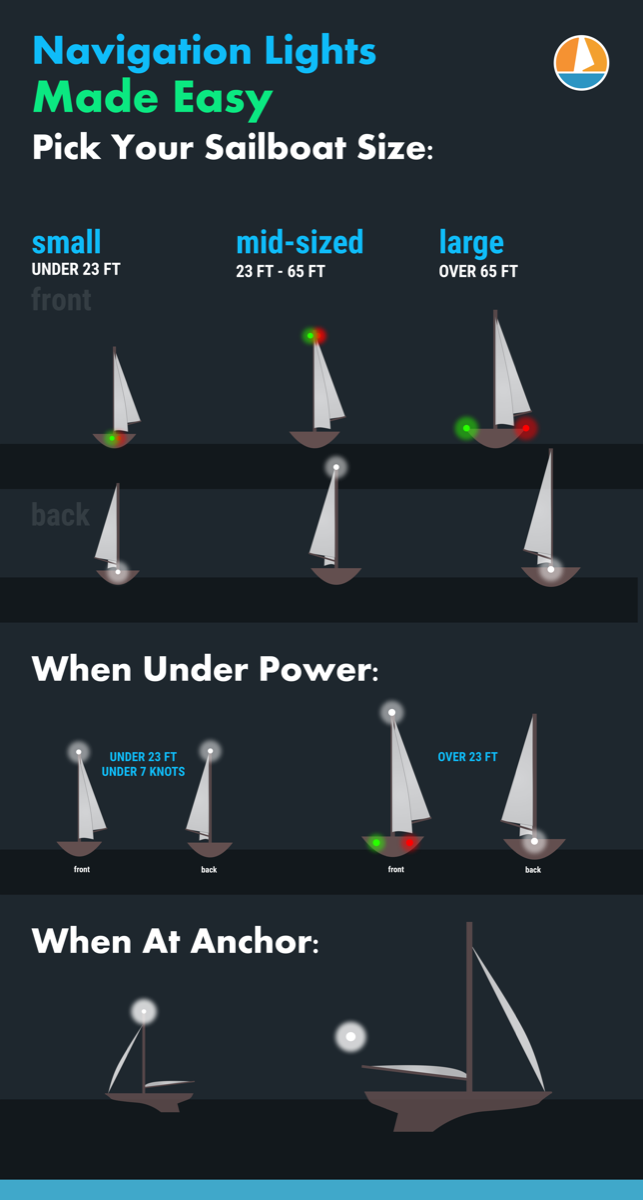
Leave a comment
You may also like, 17 sailboat types explained: how to recognize them.
Ever wondered what type of sailboat you're looking at? Identifying sailboats isn't hard, you just have to know what to look for. In this article, I'll help you.

The Ultimate Guide to Sail Types and Rigs (with Pictures)
Own your first boat within a year on any budget.
A sailboat doesn't have to be expensive if you know what you're doing. If you want to learn how to make your sailing dream reality within a year, leave your email and I'll send you free updates . I don't like spam - I will only send helpful content.
Ready to Own Your First Boat?
Just tell us the best email address to send your tips to:

Please verify you are a human
Access to this page has been denied because we believe you are using automation tools to browse the website.
This may happen as a result of the following:
- Javascript is disabled or blocked by an extension (ad blockers for example)
- Your browser does not support cookies
Please make sure that Javascript and cookies are enabled on your browser and that you are not blocking them from loading.
Reference ID: 391778a4-ef8a-11ee-b1e8-ed403d71f016
Powered by PerimeterX , Inc.
- Upcoming Course Schedule
- Testimonials
- Get a Conservation ID
Sailboat Lights
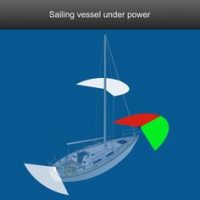
Sailboat Lights can be confusing and usually need some explanation.
Common Questions:
Is the tri-color light all I need when under power? Are the red and green lights at the top of the mast all I need? Am I supposed to turn any of these off? How then do I let others know I am under power? If you are under power, you of course need your mast head light illuminated, correct? (As seen here on the left). What if there are no pulpit or stern lights on your vessel? Shouldn’t you always use your mast lights? This is confusing!
Let’s talk it through:
Mast head lights can also be seen on power boats. Take a look at this image shown in the rules. It shows a power-driven vessel longer than 50 meters using two mast head lights.

Here is the definition of a mast head light in the rules:
A “Masthead light” means a white light placed over the fore and aft centerline of the vessel showing an unbroken light over an arc of the horizon of 225 degrees and so fixed as to show the light from right ahead to 22.5 degrees abaft the beam on either side of the vessel.
Note: It does not say the light must be at the top of the mast.
What is the tricolored light for?
Well, it is at or near the top of the mast and is for sailing vessels less than 20 meters or 65.5 feet in length. It is an optional alternative to having the lights down on the hull or pulpits. The tri-color light at the top of the mast faces a white light to the aft 135 degrees plus red from directly forward around to port 112.5 degrees and a green light directly forward and around to starboard 112.5 degrees.
This makes up 360 degrees and meets the requirement for a sailboat sailing .
So, when the sailboat turns on its engines it must also, in addition to the tri-color light at the top of the mast , display a white light 225 degrees facing forward. You can call this light whatever you’d like but it must exist. Now these particular white lights that we preferably call mast head lights , shall be visible from 6 miles. Note: It does not mean they have to be at the top of the mast. On power vessels they are typically at the top of the mast because that is what the mast is for.
Here is a sailing vessel under sail using a tricolored light. There is no forward-facing white light, like in the upper picture, so we know it is under sail.

To clarify, on a sailboat less than 50 meters in length, a white under power mast head light can be just up the mast anywhere. That is to say that it’s not part of the tri color. It is white and faces forward 225 degrees and indicates a sailboat is under power.
Where the confusion lies:
You also might be confusing the term mast head light with the two all-around red and green lights at the top of the mast. These are not mast head lights. They can be used in addition to the hull or pulpit mounted red, green, and white. A sailing vessel cannot display a top of the mast tricolored light AND the two all-around red and green at the top of the mast. Above all, the mast head is white 225 deg forward facing to be used under power only.
Pictured, the Vessel on the left is utilizing the optional two all-around red and green lights. Subsequently, this states that it is under sail or underway and not under engine power.
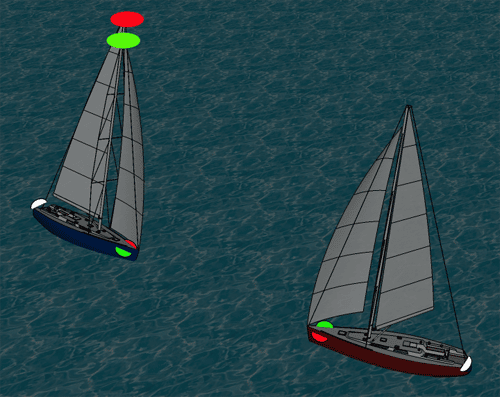
To further understand this picture, here are the rules as stated:
Rule 25 – Sailing Vessels Underway and Vessels Under Oars
(a) A sailing vessel underway shall exhibit:
(i) sidelights; (ii) a stern light
(c) A sailing vessel underway may, in addition to the lights prescribed in Rule 25(a), exhibit at or near the top of the mast, where they can best be seen, two all-round lights in a vertical line, the upper being red and the lower green, but these lights shall not be exhibited in conjunction with the combined lantern permitted by Rule 25(b).
In Conclusion:
You can further investigate using the United States Coast Guards book on Navigation Rules… NavRulesAmalgamatedwAnnexes.pdf (uscg.gov)
We are proud to discuss navigation lights in our Public Course please visit our Schedule any time. We teach all of our classes live in a virtual setting
NASBLA 2022 Accomplishments
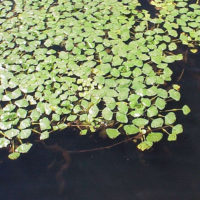
Clean Drain and Dry
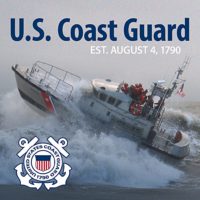
United States Coast Guard

Boating Tips for Beginners
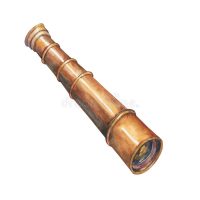
Keeping a Lookout
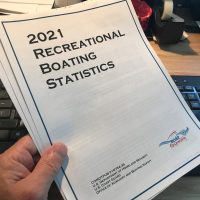
2021 Boating Accident Report Notables
- Pontoon Boats
- Personal Watercraft
- nauticalknowhow
- Nautical Knots
- Tools and Calculators
Understanding Boat Navigation Lights
Boat navigation lights are essential when you’re out on the water. They’re essential, but it’s easy to misunderstand their uses and correct placements.
If you don’t know the correct placement for your stern lights or know what type of navigation light you need on your mast, don’t worry: we’re here to help. Below, we’ve got an overview of everything you need to know about boat navigation lights: what type of navigation lights you need, where to put them, and why you need to use them.
So without further ado, let’s learn more about boat navigation lights.
What navigation lights are required on a boat?
The U.S. Coast Guard Navigation Rules, International-Inland encompasses lighting requirements for every description of watercraft. The information provided there is intended for powerboats and sailing vessels less than 20 meters. The various options are illustrated.
The U.S. Inland Rules apply inside the demarcation lines at the entrances to inlets, bays, rivers, etc. The demarcation lines are shown on coastal charts as magenta dashed lines. Once outside of the demarcation lines, International Rules apply.
Powered Vessels
Power boats less than 20 meters shall exhibit navigation lights as shown in Figure 1. (Note: 2 masthead lights are optional for vessels under 50 meters. Vessels over 50 meters will display two masthead lights.)
Vessels of less than 12 meters in length, may show the lights in either Figure 1 or Figure 2.
Powerboats less than 7 meters whose maximum speed cannot exceed 7 knots may exhibit an all-round white light, and if practicable sidelights instead of the lights prescribed above, in international waters only.
Sailing Vessels and Vessels Under Oars
Sailing vessels less than 20 meters may exhibit the navigation lights shown in Figures 3 or 4.
Another option for sailboats is to use a single combination lamp at the top of the mast as shown in Figure 5.
Sailing vessels less than 7 meters may carry an electric torch or lit lantern showing a white light to be displayed in time to prevent collision (see Figure 6 – left picture).
If possible, the lights prescribed for sailing vessels less than 20 meters should be displayed.
Vessels under oars may display the lights prescribed for sailing vessels, but if not, must have ready at hand an electric torch or lighted lantern showing a white light to be displayed in time to prevent collision (see Figure 6 – right picture).
Small boats can benefit from using a temporary LED light with a suction cup attachment if permanent fixings aren’t possible.
Shapes and Lights
To alert other vessels of conditions that may be hazardous, there are requirements to display lights at night and shapes during the day.
Anchored Vessels
Powered vessels and sailing vessels at anchor must display anchor lights. An anchor light for a boat less than 50 meters in length is an all-around white light visible for 2 miles exhibited where it can best be seen (see Figure 7).
Vessels at anchor shall exhibit forward where best seen, a ball shape (see Figure 8).
Vessels less than 7 meters are not required to display anchor lights or day shapes unless anchored in or near a narrow channel, fairway or anchorage, or where other vessels normally navigate.
Anchor lights are not required on vessels less than 20 meters, anchored in special anchorages in inland waters designated by the Secretary of Transportation.
Sailing Vessels Under Power
Vessels under sail also being propelled by machinery, must exhibit forward where best seen, a conical shape with the apex pointing down (see Figure 9).
Vessels less than 12 meters are not required to exhibit the dayshape in inland waters.
Sailing vessels operating under machinery, or under sail and machinery are considered as powered boats and must display the lights prescribed for a power-driven vessel.
Restricted Maneuverability
The Navigation Rules require vessels restricted in their ability to maneuver to display appropriate day shapes or lights. To meet this requirement, recreational vessels engaged in diving activities may exhibit a rigid replica of the international code flag “A” not less than one meter in height or at night display the navigation lights shown in Figure 10.
This requirement does not affect the use of a red and white divers flag which may be required by state or local law to mark a diver’s location. The “A” flag is a navigation signal indicating the vessel’s restricted maneuverability and does not pertain to the diver.
Navigation lights should be checked prior to departing the dock and you should always carry spare bulbs. The USCG doesn’t care if they were working when you left, only that they are working when required.
Where do navigation lights go on a boat?
The current navigation light requirements are found in the Navigation Rules, International-Inland, and in Parts 81, 84, and 89 of Title 33, Code of Federal Regulations . They’re easy to find, but many sailors and boat manufacturers do not have a good understanding of the rules governing the proper installation of navigation lights. To help clear up any misunderstandings here’s all you need to know:
Sidelights that are installed in the contour of the bow without providing a mounting surface tooled to be parallel with the fore and aft centreline of the boat are not in compliance with the Inland or International Navigation Rules. Depending on the breadth of the boat near the bow and how far aft from the vessel’s stem the lights are mounted, this shift can be more than 20 degrees in some cases. Installing the fixtures too far aft of the vessel’s stem may result in the sidelights not being visible from a position dead ahead.
Another factor in the proper installation of sidelights is that they must maintain their required minimum intensity in a vertical sector from 5 degrees above to 5 degrees below the horizontal. They must also maintain at least 60 percent of their minimum required intensity from 7.5 degrees above to 7.5 degrees below the horizontal. Installing flush-mounted sidelights, designed to be mounted to a vertical surface in the hull contour, without providing a mounting surface tooled to be vertical, shifts the vertical coverage sector. This also results in non-compliance with the Inland or International Navigation Rules.
Additionally, most of these flush-mounted sidelights are installed below the vessel’s rub rail. International Navigation Rules require that sidelights be installed above the uppermost continuous deck. Therefore, this configuration would not be in compliance with International Navigation Rules.
When separate red and green sidelight fixtures are used, the masthead light or all-round white light, whichever configuration is installed, must be located as close as practical to the vessel’s fore and aft centerline. For vessels less than 12 meters in length, the masthead light or round lights may be displaced from the fore and aft centerline providing that the sidelights are contained within a common fixture and mounted on the vessel’s fore and aft centerline. The masthead or round lights must be installed at least one meter (3.3 ft.) above the sidelights.
Which navigation lights are you required to display when anchoring your boat for the night?
Boating at night (or in reduced visibility) can present some special challenges. Not only is your depth perception lessened, but bright lights on the shore can also cast misleading reflections on the water and if you wear glasses, or worse yet bifocals, you simply don’t see as well at night as you do during the day.
It is not only important that you be able to identify other vessels operating in your proximity, it is equally important that other vessels see you. Most recreational vessels are less than 30 feet in length and, according to the Rules of the Road, shall be equipped with navigation lights.
These lights not only have a certain arc through which they can be seen but must be seen from a minimum distance. The following lighting requirements are for recreational vessels less than 12 meters in length. (approximately 39.4′)
The arc of the lights and color allows you to determine the direction a boat is moving. How good are your boat’s lights? You should test them to check your nighttime visibility, or you might land yourself in hot water with the Coast Guard.
Whether on a trailer or at the marina, switch on your lights and see how well they can be seen. Walk away from the boat or row away, if you are at anchor or at a mooring, and see how visible the lights are as you move further away. How easy are they to see against the background of lights onshore?
Does your stern light shine dead astern over the required 135º arc or does it shine to one side or up or down? Can it be seen from the required 2 miles and why is that important? As an example, let’s say that your stern lights can only be seen for 1/2 mile. You are underway at 8 knots and a large ship is approaching at 15 knots. The ship is only 4 minutes away from a collision with you. By the time the ship “might” see you, identify the light, and decide on how to move, it is too late. A ship traveling at 15 knots may take miles to stop.
Look at the stern lights again, as you move from the stern toward the bow, does the stern light “disappear” as the sidelight “appears”? The stern light should disappear and sidelight appear at 22.5º abaft the beam. If you don’t see the green starboard sidelight or the red port side light when the stern light disappears there is a problem with the arc of one or all these lights. This means that if another boat were approaching you at the angle where no lights are seen there is an increased risk of collision.
If both the stern lights and side lights are seen brightly at the same time you still have a problem. A boat approaching won’t know whether they are overtaking or crossing and whether they should give-way or stand-on.
You should also check to make sure that your masthead light disappears at the same time each side lights disappear and they both disappear when the stern light appears.
Check your sidelights from dead ahead. You should see both red and green. However, by moving toward one side just 1-3º you should then see only one light. If you still see two lights, an approaching boat won’t be able to tell which direction you’re are going.
It is very important to be seen from a distance but also for an approaching boat to be able to determine your direction of travel.
When boating at night remember the following: “When two lights you see ahead, turn your helm and show your red”.
About Chris
Outdoors, I’m in my element, especially in the water. I know the importance of being geared up for anything. I do the deep digital dive, researching gear, boats and knowhow and love keeping my readership at the helm of their passions.
Categories : nauticalknowhow
Robert Hogward on September 12, 2021
Thanks for writing this post. I can either place them on the exterior or interior for decorations. Placing them on the exterior side is helpful when I go fishing and indulging in other night activities in the water.
Dalton Bourne on July 26, 2022
We love the lights! We put lights from Seaponer on my Jon boat right above the water line and use them for night fishing! The amount of brightness it offers is an assurance of my boat’s being seen clearly during the night. At the same time, the LED lights don’t consume too much energy, leading to a life span of up to 50,000 hours.
Leave a Reply Cancel reply
Your email address will not be published. Required fields are marked *
Save my name, email, and website in this browser for the next time I comment.
More in nauticalknowhow

How to Tie a Boat to a Dock

How to Clean a Boat Cover

Everything You Need to Know About Your Boat’s Bilge Pump

4 Ways to Tie Your Boat Shoes

The People’s Poncho Review and Ratings

Oru Lake Kayak Review

What Is A Gunwale?

131 of the Best Hawaiian Boat Names

167 Patriotic Boat Names
About boatsafe.
Established in 1998, BoatSafe is your independent guide into the world of boating, fishing, and watersports. We provide expert insights and detailed guides to help you find products tailored to your needs and budget.
Contact Boatsafe
- Address: 4021 West Walnut Street. Rogers, AR 72756
- Phone: (479)339-4795
- Email: [email protected]
Site Navigation
- How We Test
- Corrections Policy
- Privacy Policy
- Terms & Conditions
- Editorial Policy
- Affiliate Disclosure
Our Reviews

All content is © Copyright 2024. All rights reserved.
- New Sailboats
- Sailboats 21-30ft
- Sailboats 31-35ft
- Sailboats 36-40ft
- Sailboats Over 40ft
- Sailboats Under 21feet
- used_sailboats
- Apps and Computer Programs
- Communications
- Fishfinders
- Handheld Electronics
- Plotters MFDS Rradar
- Wind, Speed & Depth Instruments
- Anchoring Mooring
- Running Rigging
- Sails Canvas
- Standing Rigging
- Diesel Engines
- Off Grid Energy
- Cleaning Waxing
- DIY Projects
- Repair, Tools & Materials
- Spare Parts
- Tools & Gadgets
- Cabin Comfort
- Ventilation
- Footwear Apparel
- Foul Weather Gear
- Mailport & PS Advisor
- Inside Practical Sailor Blog
- Activate My Web Access
- Reset Password
- Customer Service

- Free Newsletter

Ericson 34-2 Finds Sweet Spot

How to Sell Your Boat

Cal 2-46: A Venerable Lapworth Design Brought Up to Date

Rhumb Lines: Show Highlights from Annapolis

Solar Panels: Go Rigid If You have the Space…

Leaping Into Lithium

The Importance of Sea State in Weather Planning

Do-it-yourself Electrical System Survey and Inspection

When Should We Retire Dyneema Stays and Running Rigging?

Rethinking MOB Prevention

Top-notch Wind Indicators

The Everlasting Multihull Trampoline

What Your Boat and the Baltimore Super Container Ship May Have…

Check Your Shorepower System for Hidden Dangers

DIY survey of boat solar and wind turbine systems

What’s Involved in Setting Up a Lithium Battery System?

The Scraper-only Approach to Bottom Paint Removal

Can You Recoat Dyneema?

How to Handle the Head

The Day Sailor’s First-Aid Kit

Choosing and Securing Seat Cushions

Cockpit Drains on Race Boats


Re-sealing the Seams on Waterproof Fabrics

Safer Sailing: Add Leg Loops to Your Harness

Waxing and Polishing Your Boat

Reducing Engine Room Noise

Tricks and Tips to Forming Do-it-yourself Rigging Terminals

Marine Toilet Maintenance Tips

Learning to Live with Plastic Boat Bits
- Safety & Seamanship
- Sails, Rigging & Deck Gear
Navigation Lights: Hella and Aqua Signal Shine Brightest
Three of the four major light manufacturers serve up superlative lights-many lights even satisfied coast guard requirements at our engine-off test voltage. still, a variation of the golden rule applies: shine unto others as you would have them shine unto you..
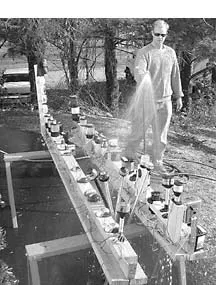
Most boats, new or used, come with navigation lights installed-and that’s about all that we care about them until one of them fails. Sometimes the failure is in the light itself, sometimes in the wiring leading to it. The fix is usually simple enough to perform mechanically or electrically, but there’s an inconvenience factor that varies from minor to major, depending on where the failure occurs. If a light goes out on the bow pulpit or cabinside, it’s no big deal. If it goes out at the top of the mast, it’s a royal pain. After the first of these pains, you begin to pay more attention to how the lights are mounted and sealed against the elements, and how the wiring is led and protected from chafe and crimping. And you begin to consider the design, construction, and materials of the lights themselves.
The other occasional concern we have with these lights is how they actually perform. Again, most of the time we take them for granted-the waters are less crowded at night, tense crossing situations are relatively infrequent, and there’s usually plenty of time to study a developing situation and make a course change if necessary. In times like that, you might feel that you have your lights on just to obey the law, nothing more.
However, when you find yourself negotiating a busy harbor or channel at night, or the visibility isn’t what it could be, or you’re traveling along a shore twinkling with houselights and floodlights and car headlights and all sorts of other distractions, you instantly appreciate running lights that are clear and bright and that stand out against the background-and you wonder just how visible yours are to others.
There are minimal visibility requirements set by the US Coast Guard-see the sidebar on pages 8-9 for the basics. But note that there’s no rule prohibiting a boat from carrying bigger, better lights than those that satisfy the minimum, as long as they don’t shine so brightly or cause so much glare that they interfere with the helmsman’s vision.
Obviously, navigation lights exist to help prevent collisions. As such, they’re important pieces of safety gear. If you suspect the ones aboard your boat are feeble, either in form or function, consider replacing them. It’s to help with your decisions on that score that we’ve done this evaluation.
Light Basics The point of navigation lights underway is to show a 360-degree circle of light at all times, including red and green sidelights, each visible through 112.5 degrees, and a stern light, visible through 135 degrees to complete the circle. On boats under 20 meters, sidelights can be combined in one unit (a bi-color light).
Powerboats underway are required to show sidelights and 360 degrees of white light. The usual configuration is sidelights, a sternlight, and a masthead light. If the boat is under 12 meters in length, an all-round white light can be substituted. The all-round white light also serves as an anchor light, required from sunset to sunrise in areas that are not designated anchorages.
On a sailboat under 20 meters, all three lights can be combined in a tri-color light at the masthead, but only when sailing; under power, a sailboat must show a 360-degree circle of white light, either in an all-around light at the masthead, or in a combination of stern light plus a 225-degree masthead light. (The masthead light is confusingly named, since it’s rarely located at the top of the mast. Usually it’s about three-quarters of the way up. On powerboats it’s usually mounted on a short pole.)
We’re referring here to boats between 7 and 20 meters in length. There are variations on the rules outside that range, but we don’t have enough paper to cover them all.
What Was Tested The last time we tested navigation lights was in 1993-the results were published in the July 1 issue of that year. We evaluated 70 lights then, and as it turns out we looked at 70 lights this time around, too, although there were some variations-missing were lights from Wilcox-Crittenden, which no longer makes them, and Forespar’s ML2 combination masthead/deck light, recommended in ’93 and still on the market (which we forgot). Otherwise we collected all the lights in the major catalogs and chandleries, including individual and bi-color sidelights, tri-color lights, sternlights, masthead lights, and all-round white lights. The lights were represented by four manufacturers-Aqua Signal, Attwood, Hella Marine, and Perko.
How We Tested Our evaluations were simple: All the lights were mounted on pine planks and properly bedded and sealed. On a chilly October night with virtually unlimited visibility, we took the planks to a local beach parking lot with little ambient light around, and set them on sawhorses. With our observer (the keenest-eyed among us) anchored offshore at one nautical mile, we powered each light individually, and the observer called in his impressions via cell phone.

We had noted that the American Boat and Yacht Council (ABYC), in their specs for the Intensity/Nominal Voltage Test for nav lights, says that the test fixture “shall be tested for its ability to meet minimum required luminous intensity… when operated at its intended nominal system voltage. This shall be a single reading at a point selected by the fixture manufacturer.”
That leaves the manufacturers quite a bit of wiggle room to balance bulb characteristics against input voltages in order to achieve their visibility requirements.
We decided to see how the lights would do in less forgiving circumstances. For power we used a truck-mounted 4-D deep-cycle marine battery monitored throughout the test at 12.4 volts-a standing voltage that would approximate power to the lights with the boat’s engine off and the supply battery in reasonably good shape, but with one or two other power demands being made on it at the same time-nav instruments and an interior light or two.
Obviously, with the engine running and an alternator output of 13 volts or more, the lights will shine brighter-so the ratings in our chart should be seen as pessimistic across the board.
After looking at all 70 lights and communicating his ratings at 1 nm, the observer moved out to 2 nm and the whole procedure was repeated. The planks were adjusted as necessary to give the observer the full proper view of each type of light. Occasionally it appeared to the testers on shore that the powered light was mounted close enough to its neighbor that it was picking up an extra reflection. In those cases they inserted a brown clipboard between the lights. It didn’t seem to make much difference.
After the visibility tests, all the lights were sprayed forcefully with a gardenhose and left to sit for two weeks. Then they were sprayed again and checked for continued function. All lights functioned fine after both inundations.
Finally, we studied the lights for quality of construction, mounting methods, and ease of maintenance. Comments on these topics are included in the main chart (see bottom).
We didn’t measure each lens for its required cuto-off angle (e.g. 112.5), reasoning that even if we were persnickety enough to find lights that were a degree or two off either way, such minor anomalies would be of little consequence on the water.
What We Found The chart provides specifics about the lights and our visibility tests. In general, we found that lights met the minimum visibility requirements at 1 mile, with the exception of two red sidelights-the Aqua Signal 22300-1 and the Attwood 3150R7.
Twenty-two lights, nine of which were rated at 2 nautical miles, were invisible at that distance and at our unforgiving voltage. Again, all lights must meet their Coast Guard requirements when powered at the test voltages allowed their manufacturers.
We should note that Hella Marine’s Model 62149 red sidelight, a 3-nm light, is rated to burn a 29-watt bulb at 13 volts, so it was unfairly underpowered in the test. Maybe it’s just for powerboats.
The fit and finish of the lights varied quite a bit, and those variations are often reflected in the price. Only one light, Perko’s Model 170BMD masthead/decklight combination arrived with an obvious flaw-a 4-mm separation in one side of the plastic housing.
A few lights were quite a bit brighter and more visible than the rest of the pack. Only five lights rated good at 2 nm: Aqua Signal’s 40100-1 bi-color light and 40400-1 masthead; Hella Marine’s 62208 stern light, 62206 masthead, and 6225 tri-color. (This tricolor was actually the most visible of all the lights in the test, scoring “excellent” at 1 nm and “good” at 2 nm.)
Some sidelights that were rated for only one nautical mile were still visible at two, even if they were only dimly seen at both distances. Those two achievements-overall brightness and staying power, were, to our minds, the top rating criteria.
See the big chart for further comments. See the recommendations box on page 5 for our picks by light type.
Navigation lights are easy to take for granted, but like so many other bits of safety and navigation gear on a boat, there may eventually come a time when they really need to shine.
Contacts- Attwood, 1016 N. Monroe St., Lowell, MI 49331; 616/897-9241. Hella Marine, 201 Kelly Dr., Peachtree City, GA 30269; 877/224-3552; www.hellana.com . Aqua Signal, 1125 Alexander Court, Cary IL, 60013; 847/639-6412. Perko, Inc., 16490 NW 13th Ave., Miami, FL 33169; 305/621-7525; www.perko.com/ .
Also With This Article Click here to view “Most Visible Lights.” Click here to view “Value Guide: Navigation Lights.” Click here to view “Light Rules.”
RELATED ARTICLES MORE FROM AUTHOR
What your boat and the baltimore super container ship may have in common.
These best boat navigation lights are what most boaters have on their marine vessels for safer and convenient boating trips. I use these bow lights for boat for secured and easy navigation during extreme weather conditions or poor visibility.
Unfortuntately, the links to additional information at the bottom of this article are broken. (Error 404 – not found) Any way to get them fixed?
This may not be the correct location to ask this question about Nav Light placement so please forgive me and direct me if need be. I am mounting a Tri-color light on top of my 26 ft mast. I presently have an under power, “steaming” light on the mast at 11 feet. COLREGS require this forward facing 225 degree white light to be at least 3′ 3″ ABOVE the forward “side markers/lights”. Where do I, or anyone else, mount the steaming light?
LEAVE A REPLY Cancel reply
Log in to leave a comment
Latest Videos
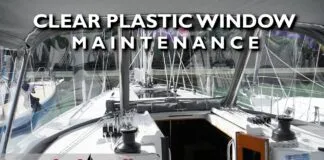
What’s The Best Vinyl Window Cleaner for Your Boat?

40-Footer Boat Tours – With Some Big Surprises! | Boat Tour

Electrical Do’s and Don’ts

Bahamas Travel Advisory: Cause for Concern?
- Privacy Policy
- Do Not Sell My Personal Information
- Online Account Activation
- Privacy Manager
Chapter 2: Boating Safety
Navigation light requirements.
Navigation lights are generally mandatory during times of limited visibility regardless of the type of vessel. These lights are invaluable because they allow boaters to identify the type of vessels around them, as well as their relative size. While learning the different arrangements which apply to different vessels, pay close attention to the differences between the navigation light requirements for unpowered and powered vessels.
Navigation Lights for Unpowered Vessels:
If a sailboat is over 23 feet (7 meters), the following standards must be met:
Unpowered boats of this size also have the option of using an all-around light set up, which is also referred to as a tricolor light.
Vessels over 23 feet (7 meters) but under 65.62 feet (20 meters) also have the option of using a combined red over green configuration mast light.
If a sailboat is under 23 feet (7 meters), the following standards must be met:
Navigation Lights for Powered Vessels:
If a powerboat is Greater than 39.4 feet (12 meters), but less than 65.6 feet (20 meters), the following standards must be met:
Additionally, the masthead must be placed at least 8 feet above the gunnel. Refer to Figure D as an example of the proper configuration. These rules also apply to sailboats using a motor.
If a powerboat is less than 39.4 feet (12 meters), the following standards must be met:
Similarly, powered vessels under 7 meters, with speeds under 7 knots, may feature a white all-around light that is visible from two miles away and, if possible, a pair of red and green sidelights in international waters only.
Additionally, the all-around white light must be positioned at least 39 inches above the sidelights. Refer to Figure A as an example of the proper configuration. Note that sailboat in Figure E is using a motor. Even if a sailboat is flying its sail it may still be under engine power, in which case, it is treated as a powered vessel. Therefore, it is vital to note the configuration of a vessel's navigation lights, and what they communicate about the vessel.
If a vessel is at anchor, the following standards must be met:
This covers the sizes of boats typically operated as a recreational boat. For larger vessels, refer to the U.S. Coast Guard Navigational Rules and Regulations Handbook.
Course Signup: Location
Privacy Policy
This privacy policy is intended to provide information to users of Boater's Academy's websites, and users of the services provided by Boater's Academy, about how Boater's Academy uses, stores, and protects information associated with such users. By using any of the websites or services of Boater's Academy, you represent and warrant that you have read and understood this privacy policy, and agree to its terms.
Effective Date Of Policy
The effective date of this privacy policy is 01/01/2018. Boater's Academy reserves the right, at any time and without notice, to add to, update, change, or modify this privacy policy by posting a new version on this page.
Information Collected By Boater's Academy
When you access Boater's Academy websites, Boater's Academy automatically gathers information that most web browsers automatically make available. This information may include IP addresses, Internet domain names, and types of devices and web browsers accessing Boater's Academy websites. Such information is anonymous and is not meant to personally identify you.
Boater's Academy websites also use cookies, which are files that are placed on your computer when you visit Boater's Academy websites. The purpose of cookies includes identifying you as a unique user of Boater's Academy websites and services, tailoring your experience on Boater's Academy websites, and enabling third-parties (such as Google) to optimize and serve advertisements to you.
If you do not wish to have cookies placed on your computer, you have several options, including: (a) not accessing Boater's Academy websites or using Boater's Academy services; (b) setting your web browser to refuse cookies; and (c) opting out of or customizing the use of third-party cookies through various websites operated by such third parties or by others (i.e., Google, Facebook, and Network Advertising Initiative). Please note that blocking or customizing the use of cookies may affect your experience on Boater's Academy websites or with Boater's Academy services.
If you decide to use certain features of Boater's Academy websites or services (such as ordering a product or service), you will be asked to provide certain personally identifiable information, which can include your name, phone number, email address, mailing address, credit/debit card number and expiration date, and social security number. You are under no obligation to provide such information, but refusing to do so may prevent your ability to use certain features of Boater's Academy websites or services.
How Boater's Academy Uses The Information It Collects
With respect to non-personally identifiable information automatically collected from you when you access Boater's Academy websites and information gathered through the use of cookies, Boater's Academy uses such information to: (1) help diagnose problems with our server and administer our websites; (2) track the usage of our websites so we can better understand who is using our websites and services and how they are using them; and (3) share with advertisers to help them better understand our services and the preferences of our customers.
Boater's Academy may combine certain demographic information obtained from you when you use certain features of Boater's Academy websites or services (such as registering or ordering a product or service) with site usage data to provide profiles, in aggregate form, about our users and their preferences. The aggregate, composite information may be shared with our advertisers.
The personally identifiable information you voluntarily provide to Boater's Academy when you decide to use certain features of Boater's Academy websites or services (such as registering or ordering a product or service) may be used for the following purposes: (1) contacting you regarding Boater's Academy's products or services, including those which you have ordered or requested; (2) billing you for the products or services your ordered or requested; (3) providing the information to third parties such as shipping companies, merchant account and payment gateway service providers, governmental entities, and our product and service distributors to the extent necessary to provide the products and services that you order or request; (4) providing the information to those who assist Boater's Academy with providing its products and services; (5) providing the information when required to do so by law or if necessary to protect the property or rights of Boater's Academy, third parties, or the public; (6) providing the information to a successor of Boater's Academy in the event of a merger, acquisition, bankruptcy, or sale of Boater's Academy's assets; and (7) providing the information to consumer credit reporting services, collection agencies, attorneys, and others in the event you fail to pay any amounts owed to Boater's Academy.
In disclosing your personally identifiable information, Boater's Academy will disclose only so much of the information as is necessary to provide the products and services that you request or order.
Security Of Information Provided To Boater's Academy
Boater's Academy takes security seriously and uses commercially reasonable safeguards to protect against the unauthorized access, use, modification, destruction or disclosure of any information you provide to us. However, Boater's Academy cannot guarantee that any information provided to us or obtained by us will not be accessed, hacked, disclosed, altered, or destroyed by unauthorized parties.
Children's Privacy
Boater's Academy does not solicit or knowingly collect personal information from children under the age of 13. If Boater's Academy obtains actual knowledge that it has collected personal information from a child under the age of 13, we will delete such information from our database. Because Boater's Academy does not collect personal information from children under the age of 13, we have no such information to use or disclose to third parties.
Parents of minors of any age may contact our Privacy Coordinator at the mailing address or e-mail address indicated below in order to: (1) access personally identifiable information Boater's Academy has collected from their child; (2) correct or modify such information; (3) request to have such information deleted; and (4) request that we no longer collect or maintain such information.
How To Request Changes To The Personally Identifiable Information We Collect
You can review and request changes to the personally identifiable information that Boater's Academy has collected from you by contacting our Privacy Coordinator at the mailing address or e-mail address indicated below.
Do-Not-Track Disclosure
Boater's Academy does not respond to "Do Not Track" signals sent by browsers.
Consent To Receive Communications
By providing your name, email, mailing address, and/or phone number to Boater's Academy, you consent to receive electronic and other communications from Boater's Academy. You may opt out of receiving electronic communications at any time by: (a) following the unsubscribe instructions contained in each communication; or (b) by contacting our Privacy Coordinator at the mailing address or e-mail address indicated below.
Third-Party Websites
Boater's Academy is not responsible for the content of websites operated by third parties to which it may provide links on Boater's Academy's websites or for the websites of advertisers. Such third parties and advertisers may also have privacy policies that are different from this privacy policy. Therefore, you should inform yourself of the privacy policies and practices of any websites of third parties or advertisers.
Contacting Us
If you have any questions about this privacy policy, Boater's Academy websites, or Boater's Academy products and services, please contact our Privacy Coordinator at the mailing address or e-mail address indicated below:
Boater's Academy Attn: Privacy Coordinator P.O. Box 5143 Virginia Beach, VA 23471 [email protected]
Terms of Use
Introduction
Welcome to Boater's Academy. This website is owned and operated by enLearned LLC. By visiting our website and accessing the information, resources, services, products, and tools we provide, you understand and agree to accept and adhere to the following terms and conditions as stated in this policy (the "User Agreement").
This User Agreement is in effect as of 01/01/2018.
We reserve the right to change this User Agreement from time to time without notice. You acknowledge and agree that it is your responsibility to review this User Agreement periodically to familiarize yourself with any modifications. Your continued use of this site after such modifications will constitute acknowledgment and agreement of the modified terms and conditions.
Responsible Use and Conduct
By visiting our website and accessing the information, resources, services, products, and tools we provide for you, either directly or indirectly (the "Resources"), you agree to use the Resources only for the purposes intended as permitted by (a) the terms of this User Agreement; and (b) applicable laws, regulations and generally accepted online practices and guidelines.
You agree that:
a. In order to access our Resources, you may be required to provide certain information about yourself (such as identification, contact details, payment information, and other information) as part of the registration process, or as part of your ability to use the Resources. You agree that any information you provide will be accurate, correct, and up to date.
b. You are responsible for maintaining the confidentiality of any login information associated with any account you use to access our Resources. Accordingly, you are responsible for all activities that occur under your account(s).
c. Accessing (or attempting to access) any of our Resources by any means other than through the means we provide, is strictly prohibited. You specifically agree not to access (or attempt to access) any of our Resources through any illegal, automated, unethical or unconventional means.
d. Engaging in any activity that disrupts or interferes with our Resources, including the servers and/or networks to which our Resources are located or connected, is strictly prohibited.
e. Attempting to copy, duplicate, reproduce, sell, trade, or resell our Resources is strictly prohibited.
f. You are solely responsible any consequences, losses, or damages that we may directly or indirectly incur or suffer due to any unauthorized activities conducted by you and you may incur criminal or civil liability for such unauthorized activities.
g. We may provide various open communication tools on our website, including but not limited to blog comments, blog posts, public chat, forums, message boards, newsgroups, product ratings and reviews, and various social media services. We do not always pre-screen or monitor the content posted by users of these various communication tools, which means that if you choose to use these tools to submit any type of content to our website, then it is your personal responsibility to use these tools in a legal, responsible and ethical manner. By posting information or otherwise using any open communication tools as mentioned, you agree that you will not upload, post, share, or otherwise distribute any content that:
i. Is illegal, threatening, defamatory, abusive, harassing, degrading, intimidating, fraudulent, deceptive, invasive, racist, or contains any type of suggestive, inappropriate, or explicit language;
ii. Infringes on any trademark, patent, trade secret, copyright, or other proprietary right of any person or entity;
iii. Contains any type of unauthorized or unsolicited advertising;
iv. Impersonates any person or entity, including any Boater's Academy employees or representatives.
We have the right at our sole discretion to remove any content that, we feel in our judgment does not comply with this User Agreement, along with any content that we feel is otherwise offensive, harmful, objectionable, inaccurate, or violates any copyrights or trademarks. We are not responsible for any delay or failure in removing such content. If you post content that we choose to remove, you hereby consent to such removal, and waive any claim against us for such removal.
h. We do not assume any liability for any content posted by you or any other third party users of our website. However, any content posted by you using any open communication tools on our website, provided that it doesn't violate or infringe on any third party copyrights or trademarks, becomes the property of enLearned LLC, and as such, gives us a perpetual, irrevocable, worldwide, royalty-free, exclusive license to reproduce, modify, adapt, translate, publish, publicly display and/or distribute as we see fit. The foregoing only applies to content posted via open communication tools, and does not apply to information that is provided as part of the registration process as part of your use of the Resources.
i. You agree to indemnify and hold harmless enLearned LLC, Boater's Academy, their parent company/companies and affiliates, and their directors, officers, managers, employees, agents, successors, assigns, and licensors (collectively, the "enLearned LLC Parties"), from and against all losses, expenses, damages and costs, including reasonable attorneys' fees, resulting from any violation of this User Agreement or the failure to fulfill any obligations relating to your account incurred by you or any other person using your account. We reserve the right to take over the exclusive defense of any claim for which we are entitled to indemnification under this User Agreement. In such event, you shall provide us with such cooperation as is reasonably requested by us.
Limitation of Warranties
The enLearned LLC Parties expressly disclaim any and all warranties, express or implied, regarding the Resources, arising by operation of law or otherwise, including without limitation any and all implied warranties of merchantability, quality, accuracy, fitness for a particular purpose, non-infringement, no encumbrance, or title, in addition to any warranties arising from a course of dealing, usage, or trade practice.
The Resources are provided with all faults, and the entire risk as to satisfactory quality, performance, accuracy, and effort is with the user.
The enLearned LLC Parties do not warrant that the Resources will fulfill any of your particular purposes or needs, or that the operation or use of the Resources will be uninterrupted or error-free. The enLearned LLC Parties disclaim all implied liability for damages arising out of the furnishing of the Resources pursuant to this User Agreement, including without limitation, mistakes, omissions, interruptions, delays, tortious conduct, errors, representations, or other defects arising out of the failure to the furnish the Resources, whether caused by acts of commission or omission, or any other damage occurring.
Limitation of Liability
In conjunction with the Limitation of Warranties as explained above, you expressly understand and agree that your potential recovery for any claim against the enLearned LLC Parties arising from or relating to the Resources or this User Agreement shall be limited to the amount you paid, if any, for use of products and/or services. The enLearned LLC Parties will not be liable for any direct, indirect, incidental, consequential or exemplary loss or damages which may be incurred by you as a result of using the Resources, or as a result of any changes, data loss or corruption, cancellation, loss of access, or downtime.
Copyrights, Trademarks, and License
Subject to your compliance with this User Agreement, the enLearned LLC Parties grant you a non-exclusive, non-sublicensable, revocable as stated in this User Agreement, non-transferable license to access the Boater's Academy websites, and to use the Resources. The Resources, including any portion of Boater's Academy websites, may not be reproduced, duplicated, copied, modified, sold, resold, distributed, transmitted, or otherwise exploited for any commercial purpose without the prior, express written consent of the enLearned LLC Parties. All rights not expressly granted in this User Agreement are reserved by the enLearned LLC Parties. Without limitation, this User Agreement grants you no rights to the intellectual property of the enLearned LLC Parties or any other party, except as expressly stated in this User Agreement. The license granted in this section is conditioned on your compliance with this User Agreement. Your rights under this section will immediately terminate if you breach, actually or potentially, in the sole judgment of the enLearned LLC Parties, any provision of this User Agreement.
Termination of Use
You agree that we may, at our sole discretion, suspend or terminate your access to all or part of our website and Resources with or without notice and for any reason, including, without limitation, breach of this User Agreement. Any suspected illegal, fraudulent or abusive activity may be grounds for terminating your relationship with Boater's Academy and may be referred to appropriate law enforcement authorities. Upon suspension or termination, your right to use the Resources we provide will immediately cease, and we reserve the right to remove or delete any information that you may have on file with us, including any account or login information.
By using or accessing Boater's Academy websites and the Resources, you represent and warrant that you have read and understood the Privacy Policy, which is incorporated by reference into this User Agreement, and agree to be bound by its terms. The Privacy Policy is available at http://boatersacademy.com/index#privacy .
Dispute Resolution, Governing Law, Attorneys' Fees
This User Agreement shall be governed and construed in accordance with the laws of the Commonwealth of Virginia without regard to its conflict of law principles.
Any and all claims, actions, demands, causes of action, and other proceedings ("Claim" or "Claims") involving you and any of the enLearned LLC Parties arising from or relating to the Resources or this User Agreement shall be heard in a court or courts of competent jurisdiction in Virginia Beach, Virginia. You hereby agree to personal jurisdiction by such courts, and waive any jurisdictional, venue, or inconvenient forum objections to such courts.
You agree that any Claim you bring against any of the enLearned LLC Parties will only be in your individual capacity and not as a plaintiff or class member in any purported class or representative proceeding.
If any of the enLearned LLC Parties initiates a Claim against you arising from or relating to the Resources or this User Agreement, the enLearned LLC Parties will be entitled to recover from you their reasonable costs and attorneys' fees incurred as a result of such Claim. If you initiate a Claim against any of the enLearned LLC Parties arising from or relating to the Resources or this User Agreement, and any of the enLearned LLC Parties prevail on such Claim, the enLearned LLC Parties will be entitled to recover from you their reasonable costs and attorneys' fees incurred as a result of such Claim.
REFUND POLICY
Refunds will only be issued in the event that you are unable to access the Resources through no fault of your own (i.e., due to an outage or other non-functionality of Boater's Academy websites) for a period forty-eight (48) hours commencing with the time that you register and pay for access to the Resources. No refunds will be issued once you receive a Certificate of Completion.
CONTACT INFORMATION
If you have any questions or comments about this User Agreement, you can contact us at:
Boater's Academy P.O. Box 5143 Virginia Beach, VA 23471 [email protected]
Steaming Light on Sailboat: A Guide to Proper Usage
by Emma Sullivan | Aug 11, 2023 | Sailboat Maintenance

== Short answer: Steaming light on sailboat == A steaming light is a white navigation light fitted on the mast of a sailboat to provide visibility during low-visibility conditions. It is typically placed near the front side of the mast and angled downwards to indicate that the vessel is under power and moving forward. This light helps other boats identify and avoid collisions, ensuring safe navigation at night or in limited visibility situations.
Understanding the Purpose of a Steaming Light on a Sailboat: What You Need to Know
Have you ever been out on a sailboat and noticed a small light at the top of the mast? You might have wondered what its purpose is or why it’s necessary. Well, that little light is called a steaming light, and it plays a crucial role in ensuring safety and navigation on a sailboat . In this blog post, we will dive into the details of understanding the purpose of a steaming light on a sailboat.
To begin with, let’s clarify what exactly a steaming light is. A steaming light is a white-colored navigation light located on the front of the mast or near the bow of a sailboat. Its main function is to provide visibility to other vessels during low-light conditions or at night. This means that whether you’re sailing in foggy weather, dim lighting, or after sunset when natural visibility decreases, the steaming light will maximize your boat’s presence to prevent collisions with other boats.
So why is it specifically called a “steaming” light? The term “steaming” refers to sailing when using an engine rather than relying solely on wind power. When you are using your boat’s engine for propulsion instead of sailing with just your sails, it is known as “motoring” or “steaming.” The steaming light got its name because it primarily signifies that the vessel has powered propulsion engaged rather than utilizing only wind power.
Now that we know what a steaming light does and where it gets its name from let’s discuss more about its importance. One major reason for having this navigation aid onboard is compliance with international boating regulations and standards set by organizations like COLREGs (Convention on the International Regulations for Preventing Collisions at Sea). These regulations ensure safe navigation practices globally and require boats to display certain lights for visibility purposes both to avoid accidents and allow other captains to understand their intentions.
When operating under engine power, displaying only proper red (port) and green (starboard) sidelights can confuse other boaters, as these lights typically indicate the presence of a vessel under sail. To avoid such confusion, the use of a steaming light in conjunction with the appropriate sidelights clarifies that the boat is motoring and not just relying on its sails for propulsion.
Another important aspect to note about steaming lights is their distinct positioning on a sailboat . Typically, they are mounted at least one meter above the deck level to ensure maximum visibility. This height allows for unobstructed illumination, making it easier for other boaters to see your vessel from afar. It’s crucial to maintain this specific positioning to comply with regulations and maximize safety on the water.
In summary, understanding the purpose of a steaming light on a sailboat is essential for any sailor or boat owner. Its primary function is to provide visibility during low-light conditions or at night when using engine power instead of relying solely on wind power. By complying with international regulations and properly displaying navigation lights like a steaming light , you enhance safety by avoiding confusion between sailing and motoring vessels. So next time you’re out on the water after dusk or in foggy weather, remember the importance of that little but mighty steaming light atop your sailboat’s mast!
Step-by-Step Guide: How to Install a Steaming Light on Your Sailboat
Installing a steaming light on your sailboat might seem like a daunting task, but with the right guidance and a bit of patience, you’ll have it up and running in no time. In this step-by-step guide, we’ll walk you through the process of installing a steaming light on your sailboat, ensuring that you have a safe and well-lit vessel on your next sailing adventure.
Step 1: Gather the necessary tools and materials Before diving into the installation process, make sure you have all the tools and materials required. You’ll need a steaming light fixture, wires (preferably marine-grade), heat shrink tubing, electrical connectors, wire cutters/strippers, crimping tool, electrical tape, screwdrivers (flathead and Phillips-head), mounting brackets or screws if needed, and a drill with appropriate bits.
Step 2: Identify the ideal location for installation Finding the right spot for your steaming light is crucial as it needs to be clearly visible from all angles while ensuring it won’t interfere with other equipment or rigging. Typically, sailors prefer placing it at the masthead or near where the mast meets the deck.
Step 3: Prepare for installation Ensure that all power sources are disconnected before beginning any work. Next, carefully remove any existing fixtures or wiring from the chosen location (if applicable). If there’s already an ample power supply nearby (e.g., an existing navigation light circuit), tap into it to minimize additional wire routing.
Step 4: Mount the steaming light fixture If your chosen spot requires mounting brackets or screws for support, position them accordingly using suitable hardware. Ensure they are firmly secured to prevent any movement due to vibrations caused by sailing conditions. Attach the steaming light fixture securely to these brackets using screws provided with the fixture.
Step 5: Connect wires and ensure proper wiring configuration Strip off some insulation from both ends of each wire to be connected. Using heat shrink tubing, slide it over one end of each wire to ensure a clean finish once the connections are made. Connect the appropriate wires from the steaming light fixture to the power supply or existing wiring and secure them using electrical connectors. It’s crucial to follow a proper wiring configuration, so refer to the manufacturer’s instructions or consult a professional if needed.
Step 6: Test functionality and safety Once all connections are securely made, reconnect the power source and turn on your sailboat’s battery. Switch on your steaming light and verify that it’s functioning correctly. Check for any loose connections, flickering lights, or signs of overheating during this testing phase. If everything looks good, proceed to finalize the installation.
Step 7: Secure and protect the wires Using zip ties or cable clamps, neatly bundle and secure all wires along their path towards the power source or existing wiring nearby. This step is especially important as it prevents any accidental snagging or damage caused by movement while sailing.
Step 8: Add finishing touches To ensure long-lasting durability and protection against environmental factors (moisture, saltwater), add an extra layer of weather-resistant insulation tape around exposed wiring connections. This additional safeguard will help shield your newly installed steaming light from any potential issues that may arise due to harsh maritime conditions.
By following these step-by-step instructions carefully, you can install a steaming light on your sailboat like a pro! Not only will you be adding an essential safety feature to illuminate your vessel in low visibility situations but also enhancing its overall aesthetics for impressive nighttime sailing adventures. So don’t let darkness dampen your enthusiasm – take charge of your boat’s illumination and enjoy safe sailing every time!
Common FAQs About Steaming Lights on Sailboats: Answered!
Introduction: When it comes to sailboats, there are often many questions that arise about various aspects of their features and functionalities. One such area of curiosity is the steaming lights on these vessels . To shed some light on this topic, we have put together a list of common frequently asked questions (FAQs) regarding steaming lights on sailboats, along with their detailed answers. So without further ado, let’s dive into these queries and unravel the mysteries surrounding steaming lights!
Question 1: What are steaming lights? Answer: Steaming lights refer to a specific type of navigation light installed on sailboats . These lights are commonly found on the front or aft of a vessel and emit a white light that extends over a defined arc.
Question 2: Why are steaming lights necessary for sailboats ? Answer: The main purpose of steaming lights is to ensure the safety and visibility of sailboats while navigating in low visibility conditions or at night. By illuminating the boat from forward or aft, they help other vessels identify its position, direction, and whether it is underway.
Question 3: Are steaming lights always required to be displayed ? Answer: Yes, according to international maritime regulations (COLREGS), all mechanically propelled vessels (including sailboats) exceeding a certain length must display proper navigation lights during nighttime navigation or in times of restricted visibility. Steaming lights are an essential component of these required navigational signaling devices.
Question 4: Where should steaming lights be positioned on a sailboat ? Answer: Typically, steaming lights are mounted on either the front masthead or closer to the bow (foremost part) of the vessel . The exact positioning depends on the boat’s design and requirements outlined by local boating regulations.
Question 5: Can other colored lights be used instead of white for sailing at night? Answer: No, according to international standards, specifically Rule 23 of COLREGS, steaming lights on sailboats must emit a white color to maintain consistency and avoid confusion with other types of vessels. White lights also have the advantage of visibility at greater distances.
Question 6: Are there any rules regarding the brightness or intensity of steaming lights ? Answer: Yes, regulations exist concerning the luminous intensity required from steaming lights . However, these requirements differ depending on the length of the vessel and are specified in international maritime regulations or local boating guidelines. Sailors must ensure their steaming lights meet these specifications.
Question 7: Can steaming lights be used while at anchor or in port? Answer: No, steaming lights should not be used while a sailboat is at anchor or docked in a port. These lights are specifically designed to indicate that a vessel is underway. When anchored or moored, different lighting configurations, such as an anchor light or deck-level navigation lights, should be used instead.
Conclusion: Understanding the significance and proper usage of steaming lights on sailboats is crucial for both experienced sailors and newcomers to ensure boating safety. In this blog post, we have addressed some common questions about these navigation lights and provided detailed explanations for each query. By following international regulations and local guidelines regarding the positioning, color, brightness, and usage of these essential lighting devices, sailors can navigate their vessels confidently even in reduced visibility conditions. Remember, responsible sailing includes being knowledgeable about every aspect of your boat’s equipment – including its illuminating features!
Choosing the Right Steaming Light for Your Sailboat: Factors to Consider
Picture this: you’re sailing gracefully through the open waters, harnessing the power of the wind, when suddenly darkness descends upon you. The sun has set, and it’s time to rely on your trusty steaming light to guide your way. But wait! How do you choose the right one? Fear not, fellow sailors, for we are here to shed some light (pun intended) on this important decision. Here are some factors you should consider before picking out the perfect steaming light.
1. Regulations and Safety Standards: First and foremost, always adhere to regulations and safety standards set by maritime authorities. Different jurisdictions might have specific requirements regarding visibility range, color specifications, mounting heights, and more. Familiarize yourself with these guidelines to avoid unnecessary fines or safety hazards.
2. Visibility: Ahoy there! One of the primary purposes of a steaming light is to ensure that other vessels can see you while underway. Consider both the intensity of the light and its range. Opt for a light that boasts exceptional brightness without blinding nearby captains (we don’t want any sailors rubbing their eyes in confusion!).
3. Energy Efficiency: As responsible stewards of our oceans, sustainability should always be on our minds – even when it comes to choosing a simple steaming light. Look for LED lights as they consume significantly less power compared to traditional incandescent bulbs while providing excellent illumination throughout your journey.
4. Durability: When it comes to marine equipment, durability is essential since it may face harsh weather conditions such as intense sun exposure and heavy rainstorms – not to mention saltwater corrosion! Seek a steaming light specifically designed for marine environments; preferably made from strong materials like stainless steel or robust plastics.
5. Ease of Installation: Unless you’re an adept sailor who thrives on complex wiring tasks reminiscent of navigating through treacherous waters, selecting a steaming light that is easy to install and maintain is paramount. Look for lights that come with simple mounting options and clear instructions – nobody wants to be left in the dark (literally) while fumbling around with confusing installation manuals.
6. Compatibility: Your sailboat’s existing electrical system should be considered when choosing a steaming light. Ensure that the voltage requirements of your chosen light match those of your marine battery system. Additionally, check if the wiring connections are compatible for seamless integration.
7. Aesthetics: Ah, sailors are known for their keen sense of style! While aesthetics may not directly impact the functionality of a steaming light, many sailors take pride in outfitting their vessels with accessories that enhance its overall design. Consider opting for a sleek and modern design that complements the aesthetics of your sailboat while providing superior performance.
8. Value for Money: As much as we hate to admit it, costs play an important role in decision-making processes. Research different brands and models to find out which ones offer excellent value for money without compromising on quality or reliability. Remember, skimping on safety equipment isn’t just unwise; it could also turn into an expensive mistake down the line.
By considering these factors and conducting thorough research, you can confidently choose the right steaming light for your sailboat – ensuring safer navigation during both day and night expeditions. May your voyages always be illuminated by the perfect beacon, guiding you towards memorable adventures on the high seas !
Troubleshooting Tips for Maintaining your Steaming Light on a Sailboat
Maintaining the steaming light on a sailboat is essential for safe navigation, especially during low visibility conditions. This small but mighty light not only helps you see ahead but also signals your presence to other vessels on the water. However, as with any electrical equipment, issues can arise that require troubleshooting and maintenance. In this blog post, we will provide you with professional, witty, and clever tips to ensure your steaming light stays in top-notch condition.
1. Check the Basics: First things first – let’s start with the basics! Before diving into complex troubleshooting techniques, make sure to inspect the obvious factors that could lead to a malfunctioning steaming light. Check if it’s properly connected and securely fastened to avoid loose or faulty wiring connections—an easy fix that might save you hours of troubleshooting later!
2. Don’t Underestimate Corrosion: Ahoy there Captain! When it comes to maritime environments, corrosion is your worst enemy. The combination of saltwater spray and constant exposure can wreak havoc on electrical systems onboard; your steaming light is no exception! Regularly inspect the contacts and terminals for signs of corrosion or rust buildup. Use a brush or a fine-grit sandpaper to remove any unwanted visitors from these surfaces. Remember, a clean connection ensures optimal performance !
3. Fuse in Time Saves Nine: Some sailors tend to forget about fuses while troubleshooting their boat’s lighting system—don’t be one of them! The humble fuse protects your electrical system from potential overloads, shorts, and fire hazards caused by an unexpected surge in current flow . If your steaming light fails to illuminate even after checking wiring connections and corrosion issues, don’t overlook this vital component! Replace any blown fuses promptly according to their specifications.
4. Shine Bright Like a Pro: “A dim steaming light? Oh buoy!” Dim lights can affect visibility for both yourself and other mariners around you—so don’t compromise on this important safety feature! If your steaming light seems less luminous than usual, check for bulb degradation. Even a slightly loose bulb can significantly reduce its brightness. Tighten it up carefully or, better yet, replace it with a fresh and bright LED bulb that offers increased energy efficiency and longevity.
5. Put the Voltmeter to Work: When all else fails, put your trust in technology! The trusty voltmeter can help you diagnose electrical issues like a true sailor troubleshooter. Connect the meter to the terminals of your steaming light and measure the voltage supply when turned on. An insufficient voltage reading indicates wiring problems or potential battery drain issues that need further inspection.
6. Beware of Murphy’s Law: Ahoy there Landlubber! When troubleshooting any onboard issue, always keep Murphy’s Law in mind: “Anything that can go wrong will go wrong.” That’s why having spare parts like bulbs, fuses, and even extra wire connectors is essential for sailboat maintenance. Preparation is key when cruising on the open water !
7. Seek Help from Fellow Sea Dogs: Remember, you’re not sailing alone in this boat—a vast community of seasoned sea dogs is out there ready to lend a helping hand! Don’t hesitate to consult online forums or reach out to fellow sailors who might have encountered similar issues before. They may share their witty anecdotes and clever solutions that could solve your steaming light troubles faster than you think!
At the end of the day, maintaining your steaming light is not just about complying with maritime regulations; it’s about ensuring safe passage for both yourself and others on the waterways. By following these troubleshooting tips – from checking connections and addressing corrosion to involving technology like voltmeters – you’ll be able to maintain an illuminated path amidst challenging maritime conditions.
So set sail confidently knowing that even if darkness falls upon you (figuratively or literally), you’ll be well-prepared to troubleshoot and maintain your steaming light like a true professional sailor.
Don’t Set Sail Without It: The Importance of a Functional Steaming Light
When embarking on a sailing adventure, it’s crucial to ensure that every aspect of your vessel is in impeccable condition. From the sails to the rudder and everything in between, one essential component that often goes unnoticed is the steaming light. This small yet mighty fixture plays a significant role in ensuring both your safety and that of other sailors out on the water. In this blog post, we will explore why having a functional steaming light should never be overlooked when setting sail.
Firstly, let’s understand what a steaming light actually is. Mounted on top of the mast or at its front, the steaming light serves as an all-around white navigation light for boats under power. Its primary purpose is to help you stay visible to other vessels nearby by indicating your direction of travel at night or during periods of diminished visibility such as fog or heavy rain.
Now, you may be wondering why this seemingly inconspicuous light deserves so much attention. Well, think about it – imagine sailing through dense fog without a working steaming light! Without this beacon guiding your path, not only are you jeopardizing your own safety but also putting fellow seafarers at risk by refusing to comply with maritime regulations.
Additionally, navigating harbors and congested waterways becomes an even greater challenge without an operational steaming light. Picture yourself approaching a bustling marina late into the evening; by illuminating your boat’s foredeck with its bright white glow, the steaming light acts as a signal for others around you to be cautious and respect your right of way. This simple yet effective communication tool prevents accidental collisions and fosters harmony among boaters sharing busy waters.
But if safety isn’t reason enough to prioritize a fully functioning steaming light before each voyage, consider this: Mariners have an inherent responsibility to adhere to international maritime regulations set forth by bodies such as the International Maritime Organization (IMO). These regulations explicitly state that every vessel under power must display a white steaming light while underway during hours of darkness or limited visibility. By neglecting this requirement, you not only risk severe penalties but also jeopardize your reputation as a responsible boater.
Now that we understand the importance of a functional steaming light, it’s essential to keep it well-maintained and regularly inspected. After all, there’s nothing worse than setting sail only to have your navigation light fail at the most inopportune moment. Inspecting the wiring, replacing any worn-out bulbs, and ensuring proper alignment are simple steps that should form part of your pre-departure routine.
Remember, when it comes to sailing, “Don’t Set Sail Without It: The Importance of a Functional Steaming Light.” This unassuming yet crucial piece of equipment acts as both an indispensable safety feature and a responsible adherence to maritime regulations. So, before you embark on your next voyage, take the time to ensure that your steaming light is functioning optimally – after all, smooth seas start with being visible and considerate towards fellow sailors!
Recent Posts

- Sailboat Gear and Equipment
- Sailboat Lifestyle
- Sailboat Maintenance
- Sailboat Racing
- Sailboat Tips and Tricks
- Sailboat Types
- Sailing Adventures
- Sailing Destinations
- Sailing Safety
- Sailing Techniques

Ultimate Guide To Marine Navigation Lighting
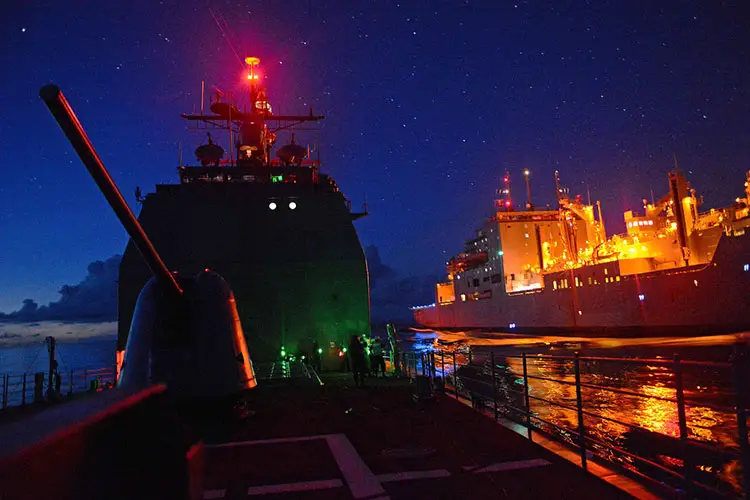
If you drive a car or even ride a bicycle, you might be well aware of the necessity of lighting systems (though in the second case the word ‘system’ doesn’t quite apply) for the safety of you and the people around you. The thing applies just as well for ships. But since they are much larger than a car, the lighting system or navigation lights on ships is a little bit more complicated as well. Marine navigation lighting is also one of the most critical aspects of nautical studies.
It is mandatory for boats of all sizes to have a navigation system . This is to make sure that the chances of any significant accident are minimized. The United States introduced the system in 1838, and the United Kingdom followed suit. Before being internationally adopted in 1897 suitable guidelines were established by the International Maritime Conference which was established in 1889. Three colors were chosen that were to be used for the light colors. They were red, green and white. This was based on a set of rules specified by the US and are followed around the world to this date.
This article discusses the different rules and regulations of using navigation lights, their importance, and also some basic marine navigation lighting systems along with their positions and ranges.
Marine Navigational Lights, Rules and Regulations
A standard pattern of marine navigation lighting is followed for the identification of both the vessel as well as the IALA buoyage system at night. If you are required to move from sea to a channel you need to have a list of all the IALA as well as the other fixed navigational lights that are visible on entering the channel. This includes distant lighthouses as well.
If you also make a note of the inland features like the radio and television transmitter masts it will benefit you because they act as good navigational aids due to their height and warning lights.
The helmsman should not be using any bright light source in the cockpit area and should rather take the aid of red lights and very dim white lights in the galley and navigation area. This is because he needs to preserve his night vision so that he can accurately interpret both the buoyage marine navigation lights as well as the boat navigation lights of other vessels.
The nautical almanacs contain the details of each and every visible maritime light signal coming from navigational markers that are both inside and outside the channel.
All the details about any particular light can be found in a published list or on a marine navigational lights chart: its color, period, and in some cases even the elevation and range of the beacon. Use the chart to keep a tag on the lights you are passing by putting a tick mark on the lights that you are about to pass and as the boat sails past, the tick is checked.
You will get two visual clues to figure out how far you are away from a buoy. The light will elevate from the horizon at 0.5 nm and at about 200m, the light will reflect on the surface.
Position of Boat Navigation Lights
Most of the variations that can be found in the different vessels can be read about in most almanacs. At the very basic level, a vessel needs to show a red light to port and green light to starboard. Depending on the size of the vessel, one or more colored or white lights are used as well.
For vessels that are 12 ft in length or shorter, the navigation lights must be visible from a range of one nautical mile and for the ones that are longer than 12 meters the required visibility range is 2 nautical miles. From 5 degrees above to 5 degrees below the horizontal happens to be the required minimum intensity in a vertical sector.
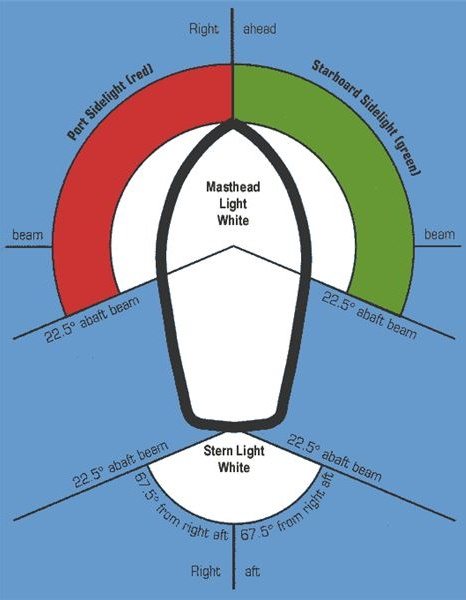
International Navigation Rules state that the boat navigation lights should be placed above the uppermost continuous deck. In case separate fixtures are used for the red and green sidelights, the masthead or all-round white light is placed as close as possible to the vessel’s fore and aft centerline. The masthead or all-around light needs to be positioned at least 1 m or 3.3 ft above the sidelights.
Following are the basic positions of navigational lights. We will discuss the same in greater detail ahead.
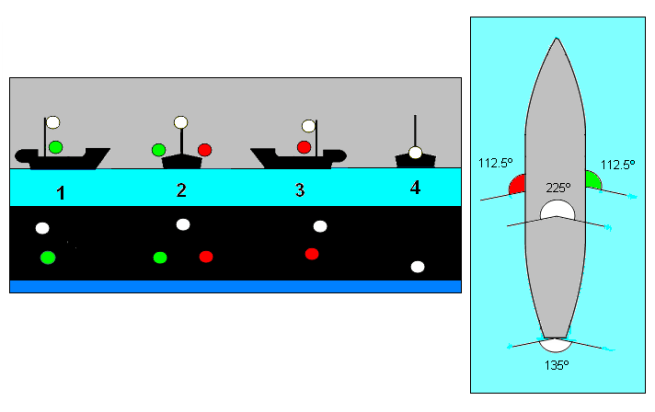
Also read: What Is A Marine Sextant?
Boat Navigation Light Regulations
Several rules and specifications are related to the type, size, layout, arc, and distance of visibility of boat navigation lights used by all vessel types which are collectively known as the International Regulations for Preventing Collisions at Sea or COLREGs . The navigational lights used are known as ‘COLREG lights and shapes. A boat might be anchored or underway, under sail or power, or fishing or trawling. These various situations can be communicated through multiple combinations of boat navigational lights.
In addition to the primary navigation lights, vessels may also display one or more steaming lights. These lights are very useful for it gives details about the various aspects of the ship like whether it is in the sail or under power, the direction in which it is going and, in some cases, even the size of the vessel. If a ship is engaged in a specific task that might involve certain restrictions, that too can be indicated with some extra boat lights.
Always maintain the lighting system and display the correct navigation light combination to make other vessels in the vicinity aware of your course and state as to whether your vessel is under power or not. If you follow this a considerable amount lowers the chances of a collision. Here is a list that you might use to familiarise yourself with the basics of the lighting system.
- Basic Navigation Light White Light : Small dinghies that are 7m or less in size are required to carry a torch having a white light that can be flashed when needed.
- All-Round White Light: An all-round white light is expected to be displayed by a small boat, up to 7ft long that is under power and can go beyond 7 knots of speed. This light must be visible at an angle of 360 degrees and from two miles away. An all-around white light is also used when the boat or vessel is at anchor but not at a designated anchoring area. This is to make sure that the ship is visible to all the nearby ships to avoid any accidents.
- Stern and Combined Side Lights : A stern light is a white light that is installed at the end of a boat. A vessel that is over 7 m or 23 ft in length is expected to show red and green sidelights when sailing. Each of these lights needs to cover an arc of 112.5°. The sidelights may be combined in one lantern at the bow when below 25 m or 65 ft. The white stern light can be seen over an arc of 135°. These lights need to be visible from a distance of a mile and need to be placed 39 inches below all white lights for boats of lengths equal to or less than 12 ft.
- Masthead Light : A combination of sidelight and stern light in a tricolor combination may be used sailing yachts of heights 20 m or lower. A masthead light is required by vessels of lengths between 39.4 ft and 65.6 ft. It is placed in the masthead whose height provides excellent visibility. Still, stern lights and sidelights should be fitted separately in case of or use under power along with steaming light. This kind of light needs to be visible across an angle of 225 degrees and from a minimum distance of 2 miles.
- Separate Lights : The displaying of the tricolor masthead light is not allowed in the case of yachts that are longer than 20 m or 65 ft. Instead, they use them separately. Often on large sailing vessels, these all-around, red over green lights are present. These red and green sidelights need to be visible from a distance of one mile and across an angle of 112.5 degrees.
- Steaming Lights Combined Lights : A combination of the masthead and stern light are used in the case of power crafts that are less than 20 m or 65 ft in length. The arrangement is present at the bow.
- Single Steaming Light : Visible over a 225 degrees arc, a masthead steaming light is used by power-driven vessels that are up to 50 m or 160 ft long. Separate stern lights and sidelights are used in case of a length exceeding 20 m or 65 ft.
- Two Steaming Lights: Power-driven vessels that span over 50 m or 160 ft in length display two masthead steaming lights. The forward light placed lower than the aft light with both of them being visible over an arc of 225° with the sidelights and separate stern light.
The area of the nautical lighting system is a precise business and requires some amount of study and a good deal of responsibility. It is because its application forms a core element in safe marine navigation.
Similar Posts
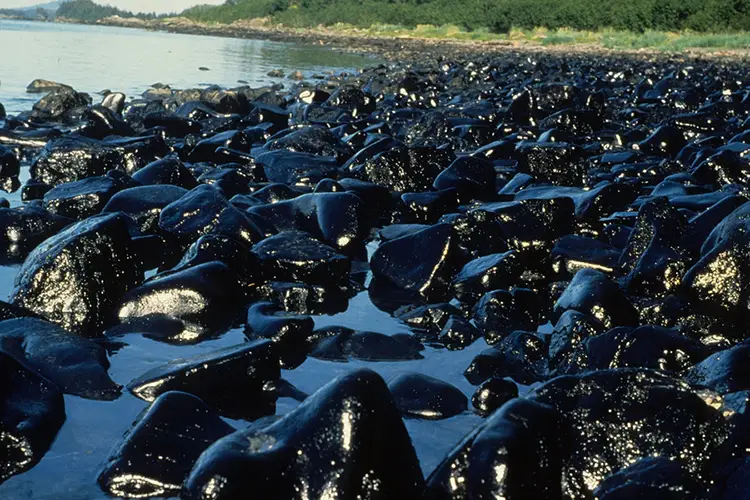
The Exxon Valdez Oil Spill Incident
Exxon Valdez oil spill was one of the worst accidents involving ocean oil spill. Today, we will uncover the true story behind it. The indispensability of oil in our day-to-day lives is unquestionable. The number of industries that are heavily reliant on oil as their source of fuel is vast. But what comes as a…

13 Major Oil Spills Of The Maritime World
An oil spill is the release of oil into the environment. Spilling of crude oil or any oil distilled product ( like gasoline, kerosene, diesel fuels, Stoddard solvent, hydraulic oils, lubricating oils) pollute the surface of the land, air, and water environment An oil spill is a kind of environmental pollution. Oil spill affects marine…

Ancient Seaports of India
It may come as a surprise to many people that India has a rich history of shipbuilding and Indians were quite accomplished seafarers. This obviously means that India also had many seaports in the past. Here is the list of ancient seaports of India. All of these ports were a hub of trade and commerce…
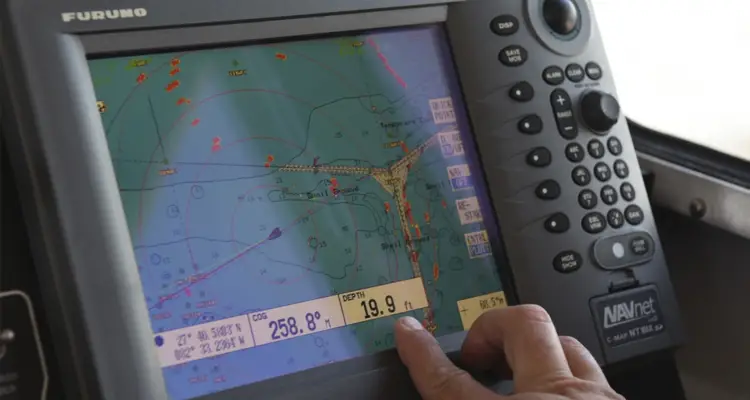
Automatic Identification System
Modern-day ships are equipped with several modern equipment and safety measures to ensure a smooth and successful voyage. These new techniques have emerged and evolved from years and years of study, research and experimenting. One such system is the Automatic Identification System or AIS. This article discusses the meaning of this term, the purpose and…
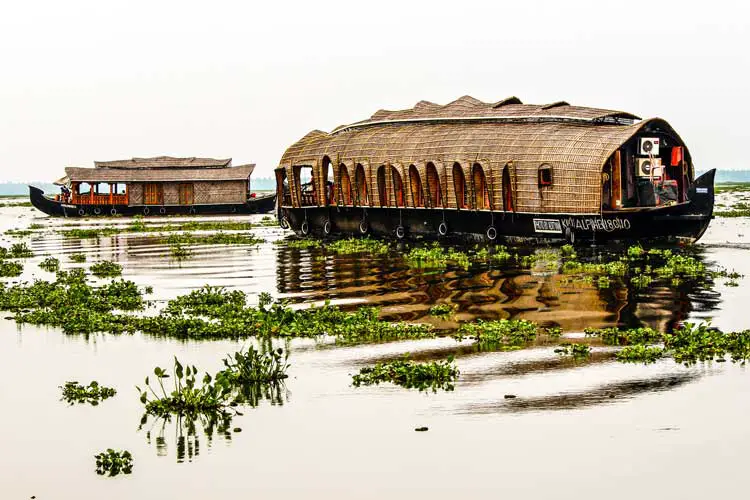
What Are Houseboats?
What Is A Houseboat? A houseboat as the name suggests is a boat that is constructed or modified to be used as a home. They are a result of a unique combination of housing and boating and are used for residential or recreational purposes. They are used as an alternate residency in many parts of…
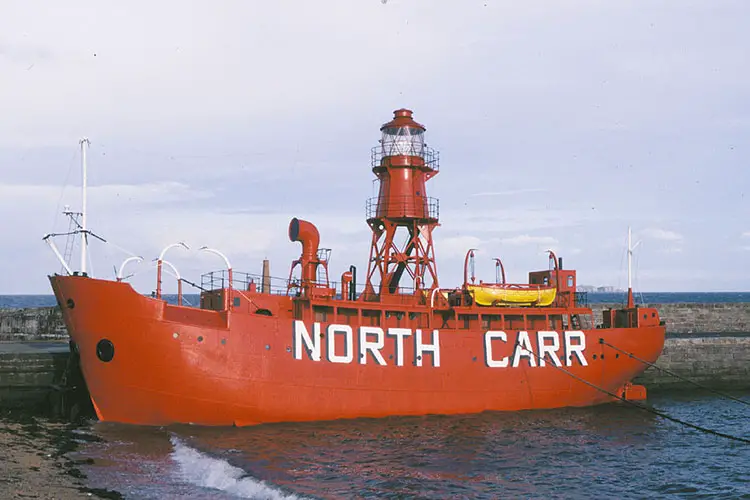
What Is A Lightship?
What is a Lightship? A lightship or a light vessel is a ship that can also operate as a lighthouse. These types of ships are used in waters that are too deep and where lighthouses cannot be constructed. Lightships play an important role in assisting other ships to navigate through waters. A lighthouse is a…
Leave a Reply Cancel reply
Your email address will not be published. Required fields are marked *
Save my name, email, and website in this browser for the next time I comment.
This website uses cookies to improve your experience. We'll assume you're ok with this, but you can opt-out if you wish. Read More
GoSailing.info Ltd
Navigation lights – colregs, navigation lights colregs.
The International Regulations for the Prevention of Collision at Sea (COLREGS) apply to all vessels upon the high seas and vessels on most waterways, bays, inlets, rivers connected to the sea.
Rule 3(a) defines ‘Vessel’ as all manner of watercraft used or capable of being used as a means of transportation on water.
Rule 20 states that all vessels must display the proper lights from sunset to sunrise and in situations where there is limited visibility.
Rule 21 Defines the various navigation lights – see below.
Masthead Light
Rule 21(a) Masthead Light: The ‘masthead light’ is a white light placed over the fore and aft centerline of the vessel showing with an arc of 225 degrees.

Sidelight s
Rule 21(b) Sidelights: Sidelights are red (port side) and green (starboard side) lights than shine in an arc of 112.5 degrees from straight ahead to a point 22.5 degrees abaft the beam.
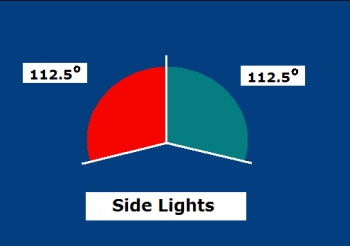
Stern Light
Rule 21(c) Stern Light: The stern light is a white light placed as near as is practicable at the stern. The light shines in an arc of 135 degrees.
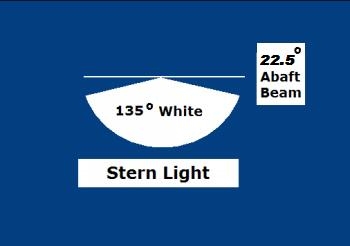
Towing Light
Rule 21(d) Towing Light: The towing light is a yellow light placed as near as is practicable at the stern. The light shine in an arc of 135 degrees.

All-round Light
Rule 21(e) All-round Light: The all-round light (such as the white anchor light) shines in an arc of 360 degrees.
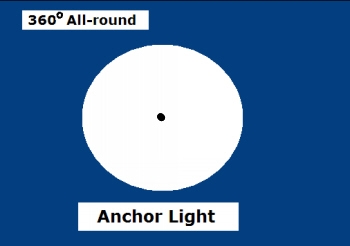
General Rules
At first glance the myriad of navigation lights and shapes don’t seem to make much sense. Here are a few basic rules to follow to make learning the navigation lights easier.
- a vessel will only have red, green sidelights and a stern light when it is underway (i.e. not anchored, moored or secured to a dock);
- if a vessel is under power it will have one or two masthead lights depending on it’s length (over 50 meters two; under 50 meters one). Since it is underway, it will also have the red, green sidelights and a stern light;
- a boat that is anchored, it is not making way and therefore it will only have one or more 360° white anchor lights depending on it’s length ( under 50 meters – one anchor light; over 50 meters but under 100 meters – two anchor lights one at the bow and one at the stern; over 100 meters – two anchor lights, one at the bow and one at the stern plus deck lights). Any vessel anchored will display a black disc which is the day shape indicating the vessel is anchored;
- a sailboat (i.e. a boat under sail alone) will have red and green sidelights and a stern light but since it is not under power, it will not have a masthead light
In addition to the above, a vessel will have other lights and day shapes to characterize the nature and activity of a boat. below.
Navigation Lights for Sail Boats – Rule 25
Rule 3(c) Defines a “sailing vessel” as any vessel under sail provided that propelling machinery, if fitted, is not being used.
Rule 25(a) Sailboats – Under Sail Only:
- Red and Green side lights;
- White Stern light.
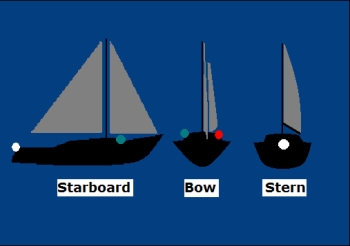
Rule 25(b)Sailboats – Optional Tri-color Light:
Sailing vessels less than 20 meters in length may use a combination mast top tri-color light in place of the standard red and green sidelights and white stern light.
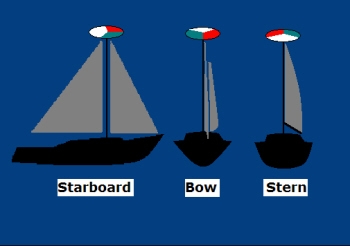
Rule 25(c)Sailboats – Optional Mast Top Lights:
Not required by law, but to make your sailboat more visible, you can use the optional Red over Green mast top lights in addition to the required:
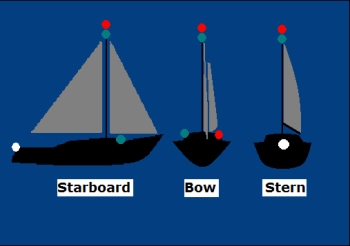
Rule 25(d)(ii)Sailboats – Less than 7 Met ers:
A sailboat less than 7 meters is not required to display lights as set out in Rule 25(a) or (b) but must have ready and at hand, an electric torch (flashlight) that shines a white light which shall be exhibited in sufficient time to prevent a collision.
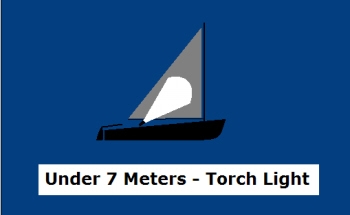
Rule 25(e) Sailboats – Under Power (Mo torsailing):
A sailboat, either fully or partially under power, for the purposes of the Rules of Navigation, is treated as a power driven vessel (powerboat). This means that if you are motorsailing, you are now considered to be a powerboat and not a sailboat.
In addition to displaying the proper lights, a vessel under sail when also being propelled by machinery shall display a conical shape, apex downwards. (Vessels under 12 meters are not required to display this day shape.)
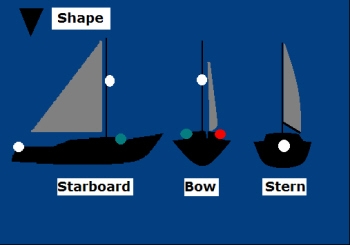
Navigation Lights for Power Boats
Rule 23(a)power boats underway – 50 meters and over:.
- Two White Masthead lights (front lower);
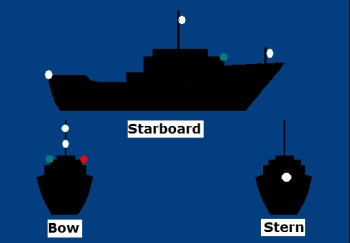
Rule 23(b)Power Boats underway – less than 50 Meters:
- White Masthead light;
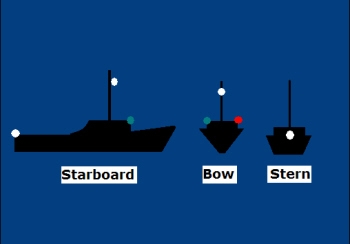
Rule 23(d)(i)Power Boats underway – under 12 Meters:
A power vessel less than 12 Meters in lieu of the lights prescribed in Rule 23(a) may exhibit:
- All-round White light.
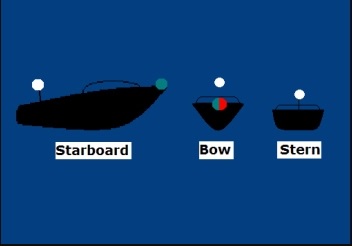
Vessels Not In Command
A vessel ‘Not in Command’ is defined in Rule 3(f) as a vessel which is unable to maneuver as required by these Rules and is therefore unable to keep out of the way of other vessels.
A vessel is underway when it is not anchored, docked, secured to the shore or aground.
Rule 27(a)(i)&(ii) Vessel Not in Command – N ot Making Way:
- Two all around Red lights, inline, one above the other;
- Shapes – two round discs, inline, one above the other.

Rule 27(a)(iii) Vessel Not in Command – Making Way:
- Red and Green sidelights;
- Stern light.
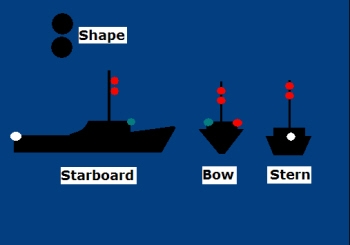
Vessels at Anchor
There is no distinction between power vessels at anchor and sailing vessels at anchor.
Rule 30(b) Vessels Under 50 Meters in length:
- An all-round white light placed where it may best be seen.

Rule 30(a) Vessels Over 50 Meters but Under 100 Meters in length:
- An all-round white light in the fore part or one ball;
- An all-round white light at or near the stern.
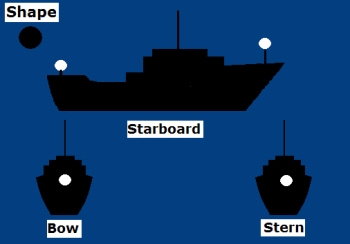
Rule 30(c) Vessels Over 100 Meters in length:
- An all-round white light at or near the stern;
- Use working or other lights to illuminate the decks.
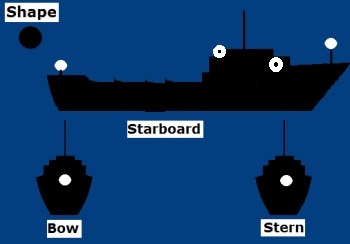
Sailing Edmonton: learn to sail with our introductory sailing lessons and Canadian Yachting Assoc. certified sailing courses – just 40 minutes West of Edmonton on Lac St. Anne. Sailboat rentals also available.
- BOAT OF THE YEAR
- Newsletters
- Sailboat Reviews
- Boating Safety
- Sailing Totem
- Charter Resources
- Destinations
- Galley Recipes
- Living Aboard
- Sails and Rigging
- Maintenance
- Best Marine Electronics & Technology
Proper Nav Lights Keep You Safe
- By Steve D' Antonio
- Updated: December 7, 2011
Running Lights
There’s one sure way to avoid being run down when sailing at night: Be seen. Make yourself visible by putting your running lights in good working order, and ensure that they comply with U.S. Coast Guard regulations. If you’re involved in a collision and your navigation lights aren’t compliant, you may be found at fault.
The most common problems involve how and where the lights are mounted. Take a careful look at each fixture; depending on the size of your vessel and its configuration of sail and power, your boat may have as many as six navigation lights: port, starboard, stern, masthead tricolor, steaming, and anchor. Make sure that no light is obstructed in any way. The usual suspects include davit-hung tenders and other stern-mounted gear as well as mast-mounted radar domes. In some cases, I’ve seen the transom itself block a portion of a stern light’s required arc of visibility.
Additionally, be sure that your side lights are mounted on surfaces that are vertical and parallel with the boat’s centerline. Side lights that are mounted on bow rails and are parallel with the rail rather than the centerline can have the effect of overlapping their red and green arcs when viewed from angles other than dead ahead, making it seem to others who are forward of you as if you’re heading directly for them when, in fact, you may not be.
Stern and masthead lights should be vertical and mounted perpendicular to the vessel’s centerline.
Side lights must be installed above the sheer line. Even if this weren’t a regulation, I’d strongly recommend replacing ones embedded in the hull; they’re less visible, particularly when the boat’s heeled, and are exposed to spray and a greater chance of immersion.
Tricolor lights can only be used when under sail. Under power, conventional deck-level lights and a steaming light must be used. At no time can both deck and tricolor lights shine simultaneously. In order to avoid this nav-light faux pas, consider installing a two-position switch (supplied by a nav-light circuit breaker) that activates either the steaming or sailing configuration.
When selecting, inspecting, and replacing navigation lights, be sure that they carry a U.S. Coast Guard approval label. Select fixtures that are appropriate for your vessel’s length, and make sure that the wattage of every bulb is correct.
Imagine disassembling a light housing with a small screwdriver while you’re hanging over a bow rail or sitting in a bosun’s chair; I prefer to use incandescent fixtures that can be serviced without tools. Remember, too, that while L.E.D. lights are virtually exempt from bulb failure, they’re no less prone to wiring and connection issues. Make certain that all nav-light wiring is fully waterproofed using either heat-shrink tubing and/or sealant. Wiring to masthead lights should be run so that its weight isn’t supported by the fixture. Navigation lights are your ally in the safe handling of your vessel. Make sure that yours can always be seen.
Steve D’Antonio offers services for boat owners and buyers through Steve D’Antonio Marine Consulting .
- More: boat maintenance , How To , maintenance , safety equipment
- More How To
How to Protect Your Spars from Corrosion
Sailing totem refit series: the forward head makeover, fatty goodlander: dealing with chafe while cruising, how to rig everything in your favor, route planning in the face of climate change, new to the fleet: pegasus yachts 50, imtra named employee-owned company of the year.
- Digital Edition
- Customer Service
- Privacy Policy
- Email Newsletters
- Cruising World
- Sailing World
- Salt Water Sportsman
- Sport Fishing
- Wakeboarding

- CLASSIFIEDS
- NEWSLETTERS
- SUBMIT NEWS
The Best Lopolight Navigation Lights for Sailboats from 12 to 20 Meters
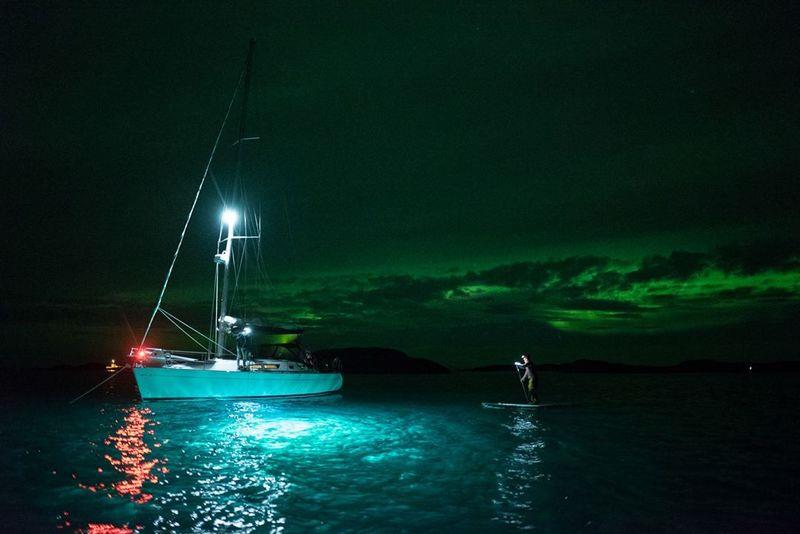
Related Articles
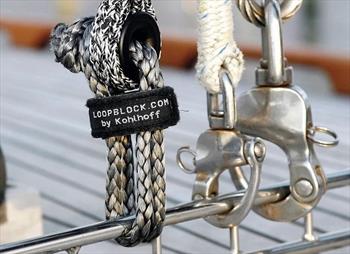
- International
March 26, 2024 - Baltimore Key Bridge collapses after ship collision
By Helen Regan , Kathleen Magramo , Antoinette Radford, Alisha Ebrahimji , Maureen Chowdhury , Rachel Ramirez , Elise Hammond , Aditi Sangal , Tori B. Powell , Piper Hudspeth Blackburn and Kathleen Magramo , CNN
Ship lights flickered and veered off course shortly before Baltimore bridge hit, CNN analysis shows
From CNN’s Allegra Goodwin in London
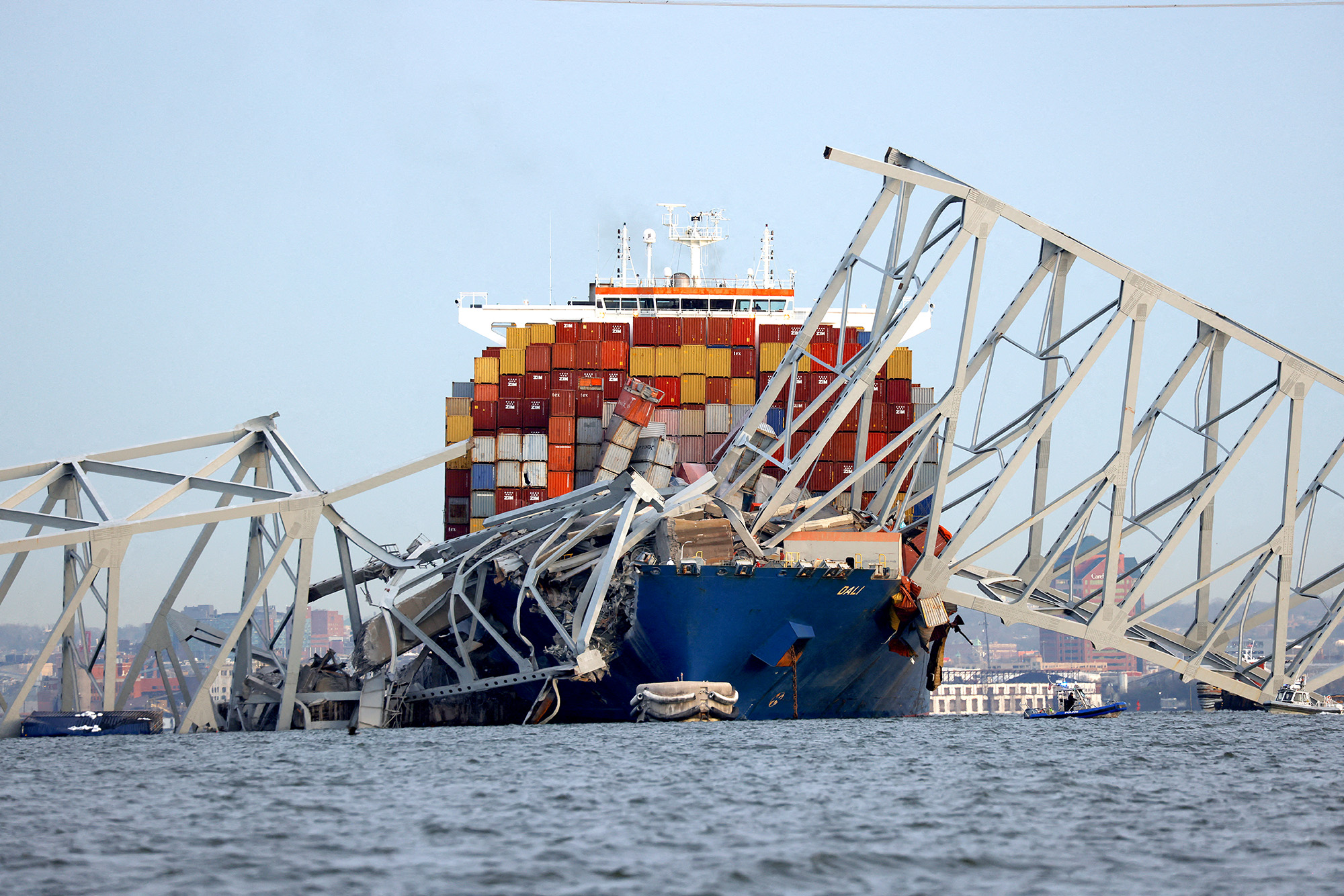
The Singaporean-flagged cargo ship that struck the Francis Scott Key Bridge in Baltimore Tuesday altered course and veered toward a pillar shortly before impact, a CNN analysis of MarineTraffic ship-tracking data confirms.
It’s unclear what caused the ship to crash into the bridge or why its lights were flickering. CNN has reached out to the National Transportation Safety Board to inquire about a possible power failure.
The container ship DALI, which was en route to Colombo, Sri Lanka, begins to change course toward the bridge’s pillar at 1:26 a.m. local time, striking the bridge at 1:28 a.m. ET, according to MarineTraffic data and video from the scene. Video from 1:25 a.m. ET shows a plume of dark smoke billowing from the ship. DALI's lights flicker at least twice before the incident.
In video, as it navigates down the Patapsco River, the ship’s lights can be seen going out at 1:24 a.m. ET, before turning back on, and then flickering off and on again between 1:26 a.m. ET and 1.27 a.m. ET, just before it hits the bridge.
Maryland transportation secretary says contractors were working on bridge at time of collapse
From CNN's Antoinette Radford
Maryland State Transportation Secretary Paul Wiedefeld told reporters there were workers on the Francis Scott Key Bridge at the time of its collapse.
"We know there were individuals on the bridge at the time of the collapse, working on the bridge, contractors for us," he said at a news conference Tuesday morning.
Wiedefeld said the workers were "basically doing some concrete deck repair," but said they did not know how many vehicles were involved.
He added that the transport authority has set up a facility for family members of those who were believed to be on the bridge at the time of its collapse.
Baltimore fire chief: Sonar has detected the presence of vehicles submerged in the water
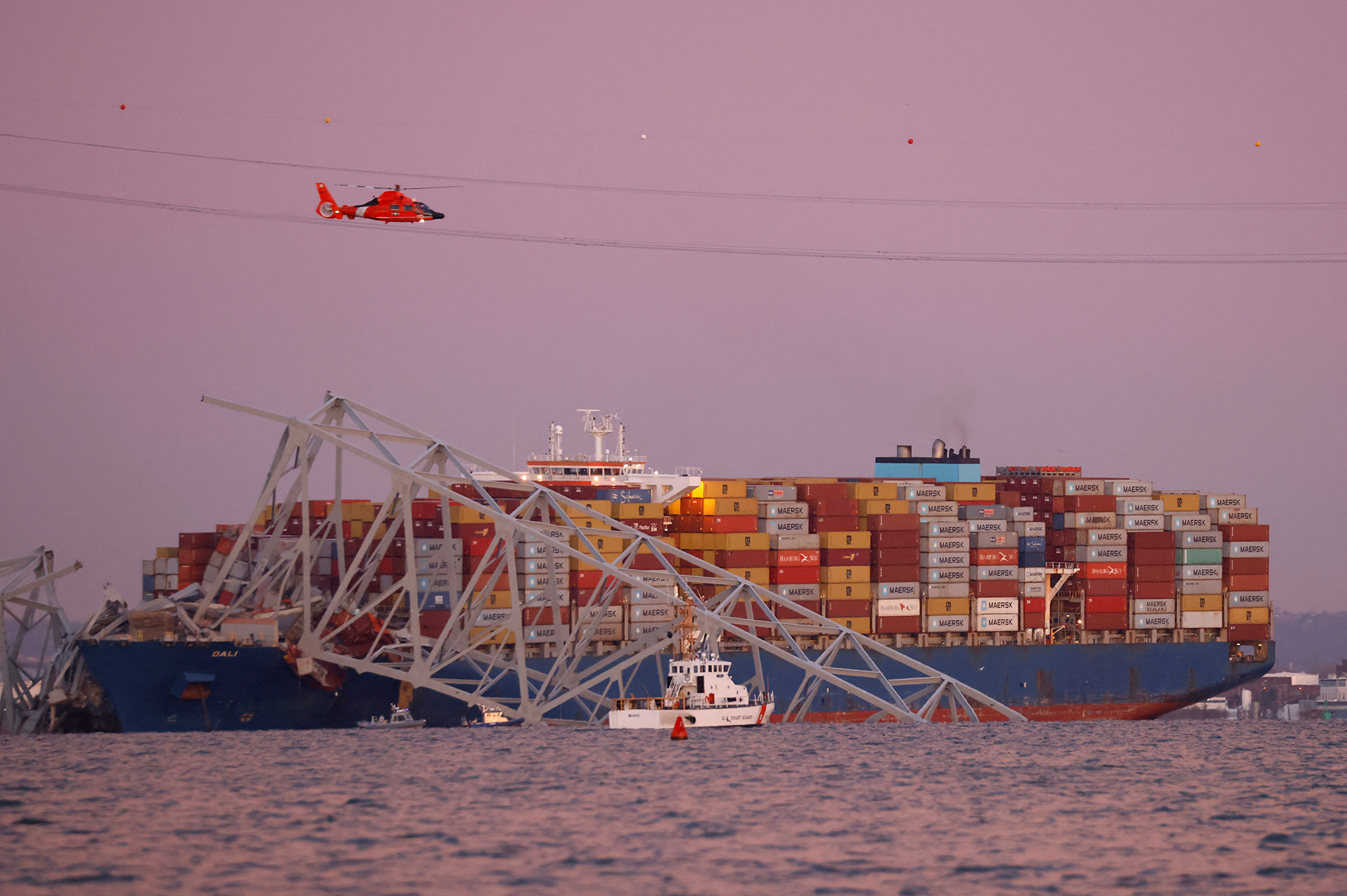
Baltimore Fire Chief James Wallace says authorities have detected vehicles submerged in the water.
“Our sonar has detected the presence of vehicles submerged in the water,” said Wallace at a news conference on the collapse of Francis Scott Key Bridge. “I don't have a count of that yet.”
He said emergency services are using sonar, drones and infrared technology as a part of their search for people and vehicles who may have fallen from the Key Bridge into the Patapsco River.
No indication of "terrorism" or intent in Baltimore bridge collapse, police chief says
From CNN’s Andy Rose
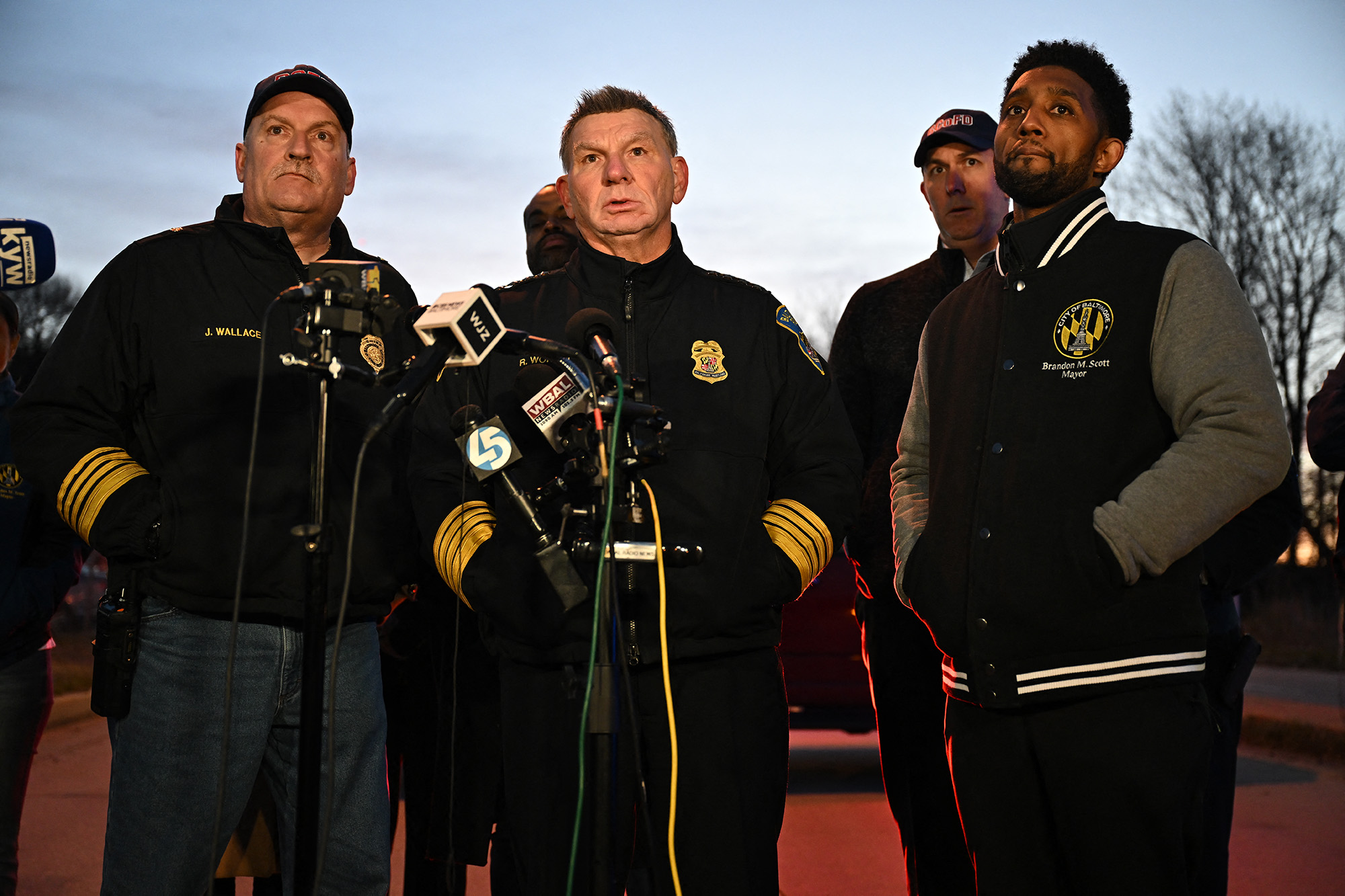
Baltimore Police said there was no evidence that the ship collision that caused the collapse of the Francis Scott Key Bridge was intentional.
“There is absolutely no indication that there's any terrorism, that this was done on purpose,” Chief Richard Worley said at a news conference.
The FBI said that it was joining the investigation into the cause of the collision.
Rescue crews have determined there are vehicles in the Patapsco River following the bridge collapse.
“Our sonar has detected the presence of vehicles submerged in the water,” said Fire Chief James Wallace. “I don't have a count of that yet.”
Wallace said they are waiting to make sure that the ship is secure and stable before investigators board it.
“Never would you think that you would see, physically see, the Key Bridge tumble down like that,” Mayor Brandon M. Scott said.
Cruises, cars and commodities: What to know about the Port of Baltimore
From CNN's Mark Thompson and Hanna Ziady
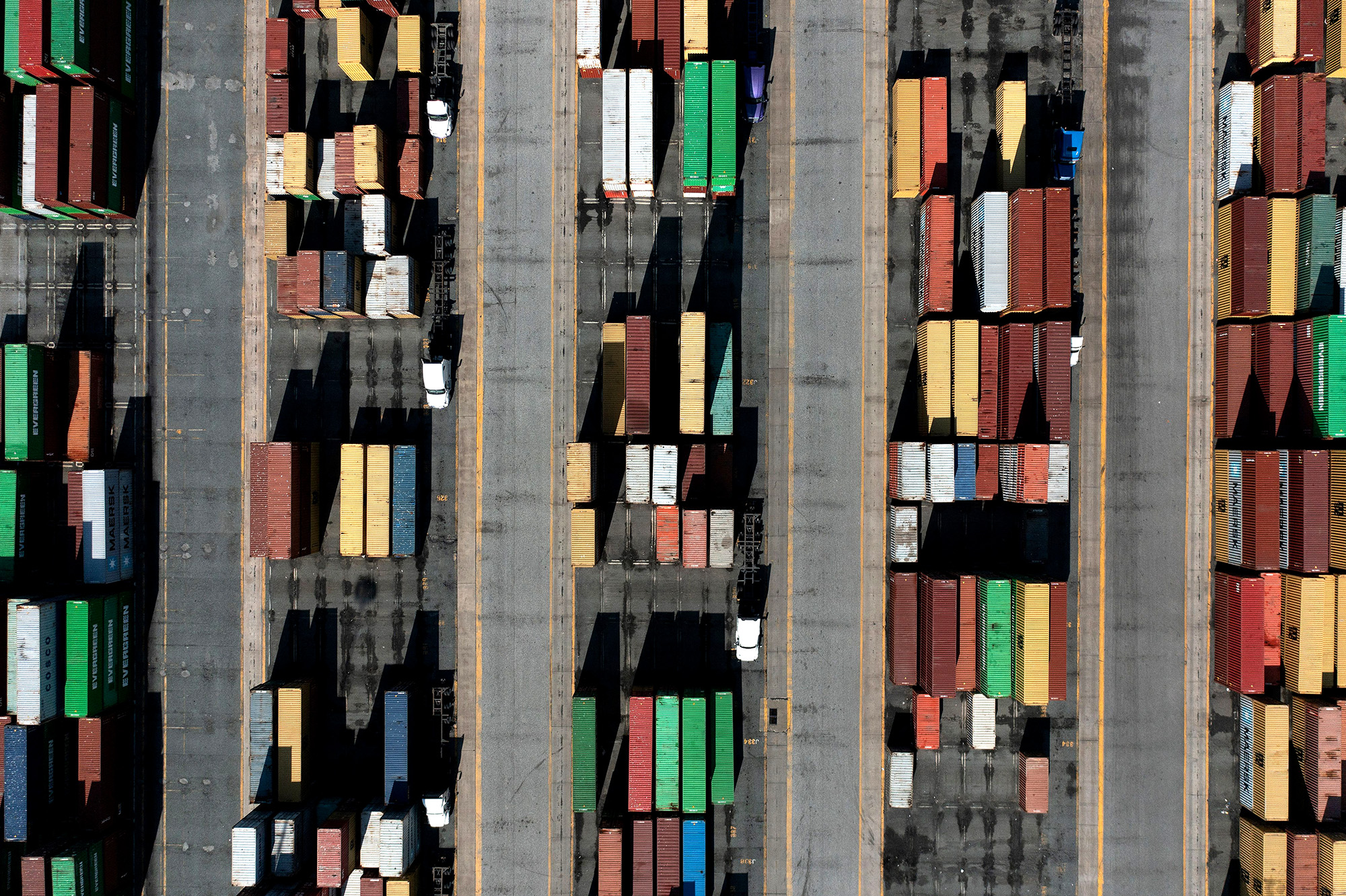
The collapse of the Francis Scott Key Bridge over the Patapsco River outside the Port of Baltimore threatens to disrupt shipping operations at a major US trade hub for autos, container traffic and commodities. Baltimore also has a cruise terminal.
Closer to the Midwest than any other port on the East Coast, Baltimore ranks first in the United States for autos and light trucks, handling a record 850,000 vehicles last year. It was also the leading port for farming and construction machinery, as well as imported sugar and gypsum. It was second in the country for exporting coal.
Overall, Baltimore ranks as the 9th biggest US port for international cargo, handling a record 52.3 million tons, valued at $80.8 billion in 2023.
“The immediate focus is the rescue operation, but there will clearly be a highly-complex recovery phase and investigation to follow and we don't know what impact this will have on operations at the Port of Baltimore," said Emily Stausbøll, market analyst at Norway-based shipping analytics company Xeneta.
“While Baltimore is not one of the largest US East Coast ports, it still imports and exports more than one million containers each year so there is the potential for this to cause significant disruption to supply chains," she added.
Baltimore's cruise terminal serves ships operated by Royal Caribbean, Carnival and Norwegian. Cruises carrying more than 444,000 passengers departed from the port last year.
According to the Maryland state government, the port supports 15,330 direct jobs and 139,180 jobs in related services.
Rescue crews looking for at least seven people in Baltimore bridge collapse
Rescue operations are underway near the wreckage of the Francis Scott Key Bridge in Baltimore, as crews look for people who fell into the Patapsco River.
“We are still very much in an active search and rescue posture at this point, and we will continue to be for some time,” Wallace added.
Baltimore Fire says two people have been rescued from the river – one who was uninjured, and another in hospitalized “very serious condition.”
“This is an unthinkable tragedy,” Mayor Brandon Scott said. “We have to first and foremost pray for all of those impacted.”
Ship that collided with Baltimore bridge was chartered by Danish shipping company Maersk
From CNN's Alex Stambaugh in Hong Kong

The container ship that collided with the Francis Scott Key Bridge in Baltimore on Tuesday was chartered by Maersk and carrying their customers' cargo, the Danish shipping company told CNN.
"We are horrified by what has happened in Baltimore, and our thoughts are with all of those affected," The company said in its statement.
The company, which has a full name of A.P. Moller - Maersk, said no company crew and personnel were onboard the vessel. It said the ship, DALI, is operated by charter vessel company Synergy Group.
"We are closely following the investigations conducted by authorities and Synergy, and we will do our utmost to keep our customers informed," the statement said.
CNN is attempting to contact the owner and managers of the ship, including Synergy.
FBI Baltimore on the scene at the Key Bridge
FBI Baltimore personnel are on the scene at the Francis Scott Key Bridge, they have said in a post on X.
The agency said it was working "side by side with our local, state and federal partners."
Baltimore fire emergency chief says 2 people saved from water after Key Bridge collapse
The Baltimore Fire Department Chief James Wallace says authorities rescued two people from the water this morning, one without injury and the other who has been transferred to hospital in a serious condition.
Authorities are continuing their search for upwards of seven people, Wallace says. But, he says that number could change as it is a "very large incident." Earlier on Tuesday, an official said as many as 20 people could be in the water.
Wallace added that the crew remains on board the ship, and are communicating with the US Coast Guard. He added that emergency services are looking into reports that there were workers on the bridge at the time of the incident.
Speaking at the press conference, Baltimore Mayor Brandon Scott also described the incident as an “unthinkable tragedy,” and offered his prayers for all those affected, as well as his thanks to first responders.
Please enable JavaScript for a better experience.
Baltimore Key Bridge collapsed in under 40 seconds, video shows
Rescuers suspended a search for survivors on Tuesday evening after a massive container ship struck Baltimore’s Francis Scott Key Bridge in the early morning, causing it to collapse into the Patapsco River below, officials said.

Marine Terminal
Approximate path
of freighter
Section of bridge
that collapsed
Transmission line
Location where freighter
Patapsco River
Source: Landsat imagery via Google Earth

Hawkins Point

The disaster halted shipping in the Port of Baltimore and severed the city’s Beltway, which is also a major artery in the busy D.C.-to-New York corridor.
Officials said a crew of at least eight construction workers repairing potholes on the bridge at the time plunged into the water. Two were pulled from the water during the search, one in serious condition and the other uninjured.
Baltimore bridge collapse

Six people who were unaccounted for after the bridge collapse are presumed dead, officials said. Efforts to find them were suspended around 7:30 p.m. on Tuesday.
The cargo ship, Dali, was captured in live-stream video moving toward the bridge at 1:24 a.m. Over the course of four minutes the lights on the ship went off and on, indicating that the power was going in and out.

01:24:22 a.m.
Dali moves southeast toward Francis Scott Key Bridge
01:24:33 a.m.
Lights go out indicating power failure
01:25:57 a.m.
Thick black smoke comes from the ship
Ship turns to the right toward bridge’s concrete pier
01:26:38 a.m.
Lights go out again after briefly returning
Source: StreamTeam Live

Police radio traffic recorded at 1:27 a.m. captures responders rushing to evacuate and hold traffic on the bridge after an officer announced that a ship had lost control of its steering, according to records from Broadcastify, an open-source audio streaming service.
“Hold all traffic on the Key Bridge,” someone says. “There’s a ship approaching that just lost their steering.”
Others announce that they are en route to the bridge or already holding traffic. One asks whether there are workers on the bridge and whether anyone can contact the “foreman to see if we can get them off the bridge temporarily.”
About a minute after the message reporting a loss of steering, someone shouts, “The whole bridge just fell down!”
At 1:28 a.m. the Dali appears to hit the bridge. Less than 40 seconds later, the bridge collapses.

01:28:50 a.m.
Dali collides with bridge
01:29:28 a.m.
Central part of the bridge collapses

TYPOGRAPHY RULES
- General type should start at 16px. Go up or down in major increments of 4 or minor increments of 2 from there.
- Type should be no smaller than 12px.
- If there are multiple graphics in a file with the same hierarchy, the headlines should be the same.
On desktop artboards (640 and above):
- Headlines should be 24px
- Any headline type over 24px should be reserved for special occasions and should be changed to Postoni.
For mobile art boards (384 and below):
- Headlines should be 20px
Dramatic video from the same live stream shows the full collapse.
The shock of the impact caused successive portions of the 1.6-mile span to bow and then fall into the Patapsco River, which is about 50 feet deep. Baltimore Fire Chief Jim Wallace said Tuesday that sonar showed multiple vehicles on the bed of the river.

Francis Scott Key Bridge
Clearance at point
of ship’s impact: About 185 feet
CAR FOR SCALE
About 200 feet
Sources: NOAA, balticshipping.com,
Maryland Transportation Authority

Sources: NOAA, balticshipping.com, Maryland Transportation Authority

Francis Scott
Clearance at point of ship’s impact: About 185 feet
Container ship
Loaded weight:
About 100,000 tons

President Biden pledged that the federal government would foot the bill to repair the bridge and reopen the Port of Baltimore, but officials said it was too soon to say how long that would take. Maryland transportation officials said drivers could expect major delays in the area. State officials said more than 30,000 vehicles a day use the bridge.

Sollers Point
rescue vessels
Dali , Maersk Ship
985 feet long
Power cables
concrete piers
main bridge span
bridge span
Photo: Carolyn Van Houten/The Washington Post

Interstate 695

Reinforced concrete piers
Submerged main bridge span
Collapsed bridge span
Maryland Gov. Wes Moore (D) said a preliminary investigation indicated that the wreck was an accident. The vessel had been traveling at a relatively rapid speed of about eight knots and lost power before the crash. The crew issued a distress signal, allowing officials to stop much of the traffic on the bridge.
The investigation into the cause was ongoing.
Júlia Ledur and Joy Sung contributed to this report.
Edited by Tara McCarty, Elyse Samuels and Tim Meko. Copy edited by Dorine Bethea and Jennifer Morehead.
How it happened: Baltimore’s Francis Scott Key Bridge collapsed after being hit by a cargo ship . The container ship lost power shortly before hitting the bridge, Maryland Gov. Wes Moore (D) said. Video shows the bridge collapse in under 40 seconds.
Victims: Divers have recovered the bodies of two construction workers , officials said. They were fathers, husbands and hard workers . A mayday call from the ship prompted first responders to shut down traffic on the four-lane bridge, saving lives.
Economic impact: The collapse of the bridge severed ocean links to the Port of Baltimore, which provides about 20,000 jobs to the area . See how the collapse will disrupt the supply of cars, coal and other goods .
Rebuilding: The bridge, built in the 1970s , will probably take years and cost hundreds of millions of dollars to rebuild , experts said.
- Baltimore bridge collapse: Crane arrives at crash site to aid cleanup March 29, 2024 Baltimore bridge collapse: Crane arrives at crash site to aid cleanup March 29, 2024
- Officials studied Baltimore bridge risks but didn’t prepare for ship strike March 29, 2024 Officials studied Baltimore bridge risks but didn’t prepare for ship strike March 29, 2024
- Baltimore begins massive and dangerous cleanup after bridge collapse March 28, 2024 Baltimore begins massive and dangerous cleanup after bridge collapse March 28, 2024

Baltimore bridge collapse latest: Six missing workers 'presumed dead'; satellite images reveal scale of bridge damage
Officials say they are transitioning from a search and rescue mission to a recovery operation "based on the length of time" and the "temperature of the water".
Wednesday 27 March 2024 00:36, UK
Please use Chrome browser for a more accessible video player
- Major bridge collapses in Baltimore after being struck by a cargo ship
- Six people still missing as two pulled from water
- Company says six workers are presumed dead
- Ship issued mayday before crash | Vessel appeared to lose power and start smoking
- Video of collapse | Satellite images reveal scale of damage
- Dali vessel involved in separate incident in 2016
- What is this bridge?
- Listen: Expert view on the Baltimore bridge collapse
Thank you for following along.
You can scroll down to catch up on the latest updates as happened during the day.
We'll be back with more news tomorrow.
Officials say they are transitioning from search and rescue operation to a recovery operation.
US Coast Guard and Maryland State Police officials say that based on the frigid temperature of the water and the length of time that had elapsed since the bridge came down there was little if any chance that the six missing could be found alive.
Maryland's senator has praised the work of first responders, saying their heroism is a "ray of light on this dark day".
Emergency workers managed to stop traffic along the Francis Scott Key Bridge after the Dali container ship put out a mayday call.
Chris Van Hollen said their actions "saved lives" and he was "thankful for them".
A team of construction workers were repairing potholes along the bridge at the time it collapsed.
Eight people were initially reported missing, but two people were found, with one suffering serious injuries.
A short while ago, we heard from the executive vice president of construction company Brawner Builders, who confirmed the six workers still unaccounted for are presumed dead.
Six workers missing after the Baltimore bridge collapsed are presumed dead, the executive vice president of Brawner Builders has confirmed.
Jeffrey Pritzker told our US partner site NBC News that there was one survivor.
The company is not releasing names at this time.
Eight people, who were working on the bridge at the time it was struck by the Dali cargo ship, were initially reported missing.
Two of them were found, with one suffering serious injuries.
The other six have been missing for more than 12 hours.
Maryland's emergency management department has raised its state activation level.
It is now registered as 'full' - meaning an incident has occurred that may require significant resources.
As a result, the state's emergency operations centre has been "fully staffed".
The state's activation levels change based on a variety of factors.
The most influential factor is the occurrence of a significant incident, which is a term used to describe a single or multi-jurisdictional incident.
A construction worker has said he was told his missing colleagues were on a break when the Dali ship crashed into the Baltimore bridge.
Jesus Campos told the AP news agency some members of staff were sitting in their trucks when the bridge collapsed.
The Brawner Builders employee said he learned about the disaster from a co-worker and immediately worried about colleagues he knew were working on the bridge.
"When he told me that, they came to mind and I was praying to God that nothing had happened to them," he added.
"It is so hard for me to describe. I know that a month ago I was there, and I know what it feels like when the trailers pass.
"Imagine knowing that it is falling. It is so hard, one would not know what to do," he said.
One person involved in the Baltimore bridge collapse has been discharged from hospital, an official at the R Adams Cowley Shock Trauma Centre has told AP.
Dr David Efron did not comment on the nature of the patient's injuries, and the hospital has not released their name.
Eight people were initially reported missing after the collapse.
Two people have been found - one was said to have serious injuries, while the other did not require hospital treatment.
Search and rescue operations are continuing this evening to find the six construction workers still missing.
The US transportation secretary has said the path to rebuilding the collapsed Baltimore bridge will not be quick or easy.
Pete Buttigieg described the bridge as "one of the cathedrals of American infrastructure".
"It has been part of the skyline for this region for longer than many of us have been alive," he said.
He has also taken the time to thank first responders and offered comfort to those "who woke up today to the news that no one wants to receive".
"This is an excruciating day for several families," he said.
Clearer satellite images have emerged of the moment the Dali container ship hit the Francis Scott Key Bridge.
The vessel crashed into the structure after issuing a mayday call and losing power.
Earlier, Maryland governor Wes Moore said the ship was travelling at a speed of eight knots at the time it sent out its distress call.
Within minutes of departure on Tuesday, the faltering container ship crashed into the Francis Scott Key Bridge.
Here is a timeline of the Singapore-flagged vessel's collision, in local time (four hours behind British time).
1.04am: Loaded with shipping containers, Dali departs from Baltimore's port, heading to Colombo, Sri Lanka.
1.24am: Dali slowly approaches the Key Bridge, according to video captured by StreamTime Live.
1.24am and 33 seconds: The ship appears to suffer a total power failure as all its lights go out.
1.25am and 31 seconds: About a minute later, the ship's lights flicker back on. Black smoke starts rising from somewhere aboard the ship.
1.26am and 37 seconds: The ship's lights go dark again.
1.27am: Dali appears to be colliding with one of the Key Bridge's piers. The US Coast Guard receives the first report of a collision.
1.27am and 10 seconds: The ship's lights come back on.
1.28am and 48 seconds: The roadway of the Key Bridge begins collapsing.
1.29am: Most of the bridge's span has plunged beneath the water.
1.40am: Baltimore City Fire Department has dispatched rescue teams for the Patapsco River, with reports of multiple people in the water.
1.50am: The first fire unit arrives on the scene.
Be the first to get Breaking News
Install the Sky News app for free

- Election 2024
- Entertainment
- Newsletters
- Photography
- Personal Finance
- AP Buyline Personal Finance
- Press Releases
- Israel-Hamas War
- Russia-Ukraine War
- Global elections
- Asia Pacific
- Latin America
- Middle East
- March Madness
- AP Top 25 Poll
- Movie reviews
- Book reviews
- Personal finance
- Financial Markets
- Business Highlights
- Financial wellness
- Artificial Intelligence
- Social Media
Easter Sunday
What we know about the Baltimore bridge collapse
A container ship lost power and rammed into a major bridge in Baltimore early Tuesday, causing it to snap and plunge into the river below. Several vehicles fell into the chilly waters, and rescuers are searching for survivors.

The Maryland Department of Transportation has requested an initial emergency relief funding of $60 million from the Biden Administration to pay for initial mobilization, operations and debris recovery from the collapse of the Francis Scott Key Bridge in Baltimore. (AP video by Nathan Ellgren)

As investigators began collecting evidence from a cargo ship that struck the Francis Scott Key Bridge, Gov. Wes Moore says the bridge will be rebuilt.

The U.S. National Transportation Safety Board released footage of the cargo ship that lost power and crashed into a bridge in Baltimore. NTSB investigators are collecting evidence from the vessel that struck the Francis Scott Key Bridge on Tuesday morning.

Baltimore’s longshoreman’s union represents the workers who load and unload the giant container ships that call on the city’s massive port. The union is working to help members who may be impacted by the port’s closure.
A container ship rests against the wreckage of the Francis Scott Key Bridge on Thursday, March 28, 2024, in Baltimore, Md. After days of searching through murky water for the workers missing after the bridge collapsed, officials are turning their attention Thursday to what promises to be a massive salvage operation. (AP Photo/Matt Rourke)
- Copy Link copied
In this image released by the National Transportation and Safety Board, a NTSB investigator is seen on the cargo vessel Dali, which struck and collapsed the Francis Scott Key Bridge, Wednesday, March 27, 2024 in Baltimore. (Peter Knudson/NTSB via AP)
A cargo ship rammed into Baltimore’s Francis Scott Key Bridge , causing the span to collapse and presumably killing six construction workers. On Wednesday, a day after the early-morning crash, officials with the National Transportation Safety Board boarded the ship and planned to recover information from its electronics and paperwork while divers searched for the bodies of workers who were still missing.
Here’s what we know so far about the collapse:
WHAT EXACTLY HAPPENED?
The operators of the Dali cargo ship issued a mayday call moments before the crash early Tuesday saying the vessel had lost power. But the 985-foot-long (300-meter-long) ship still struck one of the 1.6-mile (2.6-kilometer) bridge’s supports at 8 knots, which is roughly 9 mph (15 kph). That caused the span to break and fall into the water within seconds.
Eight construction workers were filling potholes on the bridge when the crash happened. Two were rescued soon after the collapse. Divers recovered the bodies of two others and the other four are presumed dead. Jeffrey Pritzker, executive vice president of Brawner Builders, said they were working in the middle of the span when it collapsed.
The U.S. Coast Guard said Wednesday that the ship underwent “routine engine maintenance” in the port before it lost power.
An inspection of the Dali last June at a port in Chile identified a problem with the ship’s “propulsion and auxiliary machinery,” according to Equasis, a shipping information system. The deficiency involved gauges and thermometers, but the website’s online records didn’t elaborate.
A “standard examination” conducted by the U.S. Coast Guard in New York in September didn’t identify any deficiencies, according to the Equasis data.
Given the vessel’s massive weight, it struck the bridge support with significant force, said Roberto Leon, a Virginia Tech engineering professor. The post can resist the impact by bending, Leon said, but cannot absorb the energy brought by such a “humongous ship.”
Last June, federal inspectors rated the 47-year-old bridge in fair condition. But the structure did not appear to have pier protection to withstand the crash, experts said.
“If a bridge pier without adequate protection is hit by a ship of this size, there is very little that the bridge could do,” Leon said.
Federal and state investigators have said the crash appears to have been an accident.
HOW MANY PEOPLE ARE MISSING?
Two of the construction workers who were on the bridge were rescued. The bodies of four of the six others were still missing Thursday. Searchers recovered the bodies of 35-year-old Alejandro Hernandez Fuentes and 26-year-old Dorlian Ronial Castillo Cabrera on Wednesday. They were in a pickup truck submerged in about 25 feet (7.6 meters) of water.
The workers came to the Maryland area from Guatemala, Honduras and Mexico, according to diplomats from those countries.
One worker, 38-year-old Maynor Yassir Suazo Sandoval, came to the U.S. from Honduras nearly two decades ago. His brother described him as an entrepreneurial and hard-working husband and father of two. And El Salvador’s foreign minister, Alexandra Hill Tinoco, posted Wednesday on X that one Salvadoran citizen, Miguel Luna, was among the missing workers.
The ship is owned by Singapore-based Grace Ocean Private Ltd., which said all crew members, including the two pilots, were accounted for and there were no reports of injuries.
The ship’s warning enabled authorities to limit vehicle traffic on the span. Plus, the accident occurred at 1:30 a.m., long before the busy morning rush. The bridge carried an estimated 30,800 vehicles per day on average in 2019.
WHAT IMPACT COULD THIS HAVE?
The collapse will almost surely create a logistical nightmare, shutting down ship traffic at the Port of Baltimore and snarling cargo and commuter traffic.
The port is a major East Coast hub for shipping. The bridge spans the Patapsco River, which massive cargo ships use to reach the Chesapeake Bay and then the Atlantic Ocean.
The Dali was headed from Baltimore to Colombo, Sri Lanka, and flying under a Singapore flag, according to data from Marine Traffic.
President Joe Biden said he expects the federal government to pick up the entire rebuilding cost. His administration approved $60 million in emergency federal aid to pay for debris removal and other initial costs.
“This work is not going to take hours. This work is not going to take days. This work is not going to take weeks. We have a very long road ahead of us,” Maryland Gov. Wes Moore said Thursday.
The U.S. Army Corps of Engineers and a commercial salvage company have been surveying the site as they plan the salvage operation, according to U.S. Coast Guard Chief Petty Officer Cynthia Oldham.
Coast Guard Rear Admiral Shannon Gilreath said Friday that the first goals are to reopen the shipping channel and remove the ship. The Maryland Department of Transportation and U.S. Coast Guard surveyed the damage Friday morning. Teams worked through high winds while determining how to safely cut the trusses — which weigh between 3,000 to 4,000 tons — into lighter sections that can be removed by four heavy lift cranes supplied by the U.S. Navy, according to Moore.
In the coming weeks, the governor hopes to have 10 tugboats, seven floating cranes, nine barges, eight salvage vessels and five Coast Guard boats in the water.
The collapse is not likely to have a big effect on worldwide trade because Baltimore is not a major port for container vessels, and proves more important when it comes to goods such as farm equipment and autos, said Judah Levine, head of research for global freight booking platform Freightos.
But jobs for roughly 2,400 members of the International Longshoremen’s Association Local 333 could dry up until shipping traffic resumes, according to Scott Cowan, the union’s president. Cowan said union leaders are working with elected officials to fund compensation for longshoremen in the meantime.
Authorities must also now handle a sheen in the water after some of the 56 containers onboard that were carrying hazardous materials were breached. Among the hazardous materials were corrosives, flammables and lithium ion batteries, according to the National Transportation Safety Board. But the Key Bridge Joint Information Center said Thursday that there’s no immediate environmental threat and that air monitoring has shown no volatile organic compounds. Adam Ortiz, the EPA’s regional administrator in the Mid-Atlantic states, said Friday that ongoing monitoring has not given any indication that the water contains materials hazardous to humans.
HOW OFTEN DOES THIS HAPPEN?
From 1960 to 2015, there were 35 major bridge collapses worldwide due to ship or barge collisions, with a total of 342 people killed, according to a 2018 report from the World Association for Waterborne Transport Infrastructure.
Eighteen of those collapses happened in the United States.
Among them were a 2002 incident in which a barge struck the Interstate 40 bridge over the Arkansas River at Webbers Falls, Oklahoma, sending vehicles plunging into the water. Fourteen people died and 11 were injured.
And in 2001, a tugboat and barge struck the Queen Isabella Causeway in Port Isabel, Texas, causing a section of the bridge to tumble 80 feet (24 meters) into the bay below. Eight people were killed.
This story has been updated to correct that there were more than 56 containers on the ship, but that 56 contained hazardous materials, and to correct that crews were working to cut up trusses of the collapsed bridge, not the vessel that ran into it.
Lea Skene, Brian Witte and Sarah Brumfield contributed reporting.

Baltimore bridge collapse: What happened and what is the death toll?
What is the death toll so far, when did the baltimore bridge collapse, why did the bridge collapse, who will pay for the damage and how much will the bridge cost.

HOW LONG WILL IT TAKE TO REBUILD THE BRIDGE?
What ship hit the baltimore bridge, what do we know about the bridge that collapsed.

HOW WILL THE BRIDGE COLLAPSE IMPACT THE BALTIMORE PORT?

Get weekly news and analysis on the U.S. elections and how it matters to the world with the newsletter On the Campaign Trail. Sign up here.
Writing by Lisa Shumaker; Editing by Daniel Wallis and Bill Berkrot
Our Standards: The Thomson Reuters Trust Principles. , opens new tab

Thomson Reuters
Lisa's journalism career spans two decades, and she currently serves as the Americas Day Editor for the Global News Desk. She played a pivotal role in tracking the COVID pandemic and leading initiatives in speed, headline writing and multimedia. She has worked closely with the finance and company news teams on major stories, such as the departures of Twitter CEO Jack Dorsey and Amazon’s Jeff Bezos and significant developments at Apple, Alphabet, Facebook and Tesla. Her dedication and hard work have been recognized with the 2010 Desk Editor of the Year award and a Journalist of the Year nomination in 2020. Lisa is passionate about visual and long-form storytelling. She holds a degree in both psychology and journalism from Penn State University.

Israel's Netanyahu will undergo hernia surgery on Sunday, his office says
The announcement comes as Israel wages war against Hamas in Gaza and less than a year after the prime minister was fitted with a pacemaker. Netanyahu will be under general anesthetic during the surgery.
Police in Amsterdam said on Sunday that they had cleared the area around the central Rokin metro station and that explosives experts were on the scene investigating.

Russia is demanding that Ukraine hand over all people connected with terrorist acts committed in Russia, including the head of the country's SBU Security Service, the foreign ministry said on Sunday.
Six presumed dead after cargo ship crash levels Baltimore bridge
BALTIMORE — A major Baltimore bridge collapsed like a house of cards early Tuesday after it was struck by a container ship, sending six people to their deaths in the dark waters below, and closing one of the country’s busiest ports.
By nightfall, the desperate search for six people who were working on the bridge and vanished when it fell apart had become a grim search for bodies.
“We do not believe that we’re going to find any of these individuals still alive,” Coast Guard Rear Admiral Shannon N. Gilreath said.
Jeffrey Pritzker, executive vice president of Brawner Builders, said earlier that one of his workers had survived. He did not release their names.
Up until then, Maryland Gov. Wes Moore had held out hope that the missing people might be found even as law enforcement warned that the frigid water and the fact that there had been no sign of them since 1:30 a.m. when the ship struck Francis Scott Key Bridge.
Moore expressed heartbreak after officials suspended the search for survivors.
"Our heart goes out to the families," he said. "I can’t imagine how painful today has been for these families, how painful these hours have been have been for these families."
It was a crushing blow to the loved ones of the missing men, who had waited for hours at a Royal Farms convenience store near the entrance of the bridge for word of their fate.
Follow live updates on the Baltimore bridge collapse
The tragic chain of events began early Tuesday when the cargo ship Dali notified authorities that it had lost power and issued a mayday moments before the 984-foot vessel slammed into a bridge support at a speed of 8 knots, which is about 9 mph.
Moore declared a state of emergency while rescue crews using sonar detected at least five vehicles in the frigid 50-foot-deep water: three passenger cars, a cement truck and another vehicle of some kind. Authorities do not believe anyone was inside the vehicles.
Investigators quickly concluded that it was an accident and not an act of terrorism.
Ship was involved in another collision
Earlier, two people were rescued from the water, Baltimore Fire Chief James Wallace said. One was in good condition and refused treatment, he said. The other was seriously injured and was being treated in a trauma center.
Moore said other drivers might have been in the water had it not been for those who, upon hearing the mayday, blocked off the bridge and kept other vehicles from crossing.
“These people are heroes,” Moore said. “They saved lives.”
Nearly eight years ago, the Dali was involved in an accident. In July 2016, it struck a quay at the Port of Antwerp-Bruges in Belgium, damaging the quay.
The nautical commission investigated the accident, but the details of the inquiry were not immediately clear Tuesday.
The Dali is operated and managed by Synergy Group. In a statement, the company said that two port pilots were at the helm during Tuesday's crash and that all 22 crew members onboard were accounted for.
The Dali was chartered by the Danish shipping giant Maersk, which said it would have no choice but to send its ships to other nearby ports with the Port of Baltimore closed.
The bridge, which is about a mile and a half long and carries Interstate 695 over the Patapsco River southeast of Baltimore, was "fully up to code," Moore said.
National Transportation Safety Board Chairwoman Jennifer Homendy said that her agency will lead the investigation and that a data recorder on the ship could provide more information.
"But right now we're focusing on the people, on the families," she said. "The rest can wait."
President Joe Biden vowed to rebuild the bridge and send federal funds.
"This is going to take some time," the president warned. "The people of Baltimore can count on us though to stick with them, at every step of the way, till the port is reopened and the bridge is rebuilt."
Speaking in Baltimore, Transportation Secretary Pete Buttigieg echoed the president's promise.
"This is no ordinary bridge," he said. "This is one of the cathedrals of American infrastructure."
But Buttigieg warned that replacing the bridge and reopening the port will take time and money and that it could affect supply chains.
The Port of Baltimore, the 11th largest in the U.S., is the busiest port for car imports and exports, handling more than 750,000 vehicles in 2023 alone, according to data from the Maryland Port Administration.
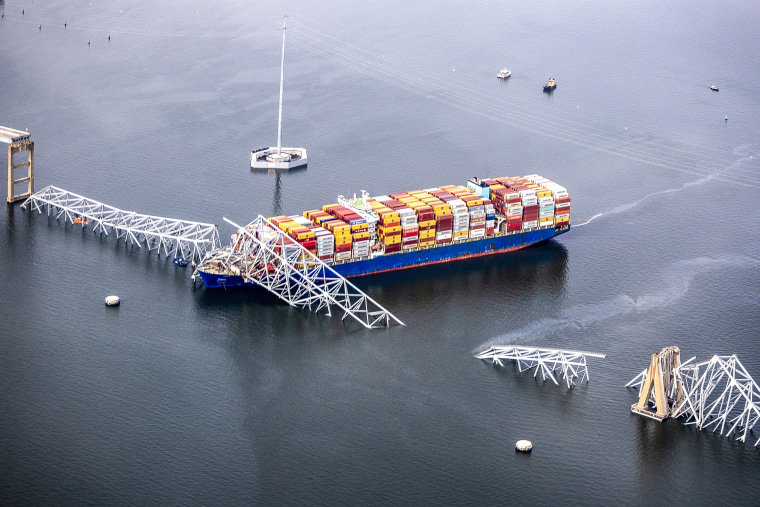
Writer David Simon, a champion of Baltimore who set his TV crime drama "The Wire" on the streets of the city he once covered as a reporter, warned online that the people who will suffer the most are those whose livelihoods depend on the port.
"Thinking first of the people on the bridge," Simon posted on X . "But the mind wanders to a port city strangling. All the people who rely on ships in and out."
Timeline of crash
Dramatic video captured the moment at 1:28 a.m. Tuesday when the Dali struck a support and sent the bridge tumbling into the water. A livestream showed cars and trucks on the bridge just before the strike. The ship did not sink, and its lights remained on.
Investigators said in a timeline that the Dali's lights suddenly shut off four minutes earlier before they came back on and that then, at 1:25 a.m. dark black smoke began billowing from the ship's chimney.
A minute later, at 1:26 a.m., the ship appeared to turn. And in the minutes before it slammed into the support, the lights flickered again.
Maryland Transportation Secretary Paul Wiedefeld said the workers on the bridge were repairing concrete ducts when the ship crashed into the structure.
At least seven workers were pouring concrete to fix potholes on the roadway on the bridge directly above where the ship hit, said James Krutzfeldt, a foreman.
Earlier, the Coast Guard said it had received a report that a “motor vessel made impact with the bridge” and confirmed it was the Dali, a containership sailing under a Singaporean flag that was heading for Sri Lanka.
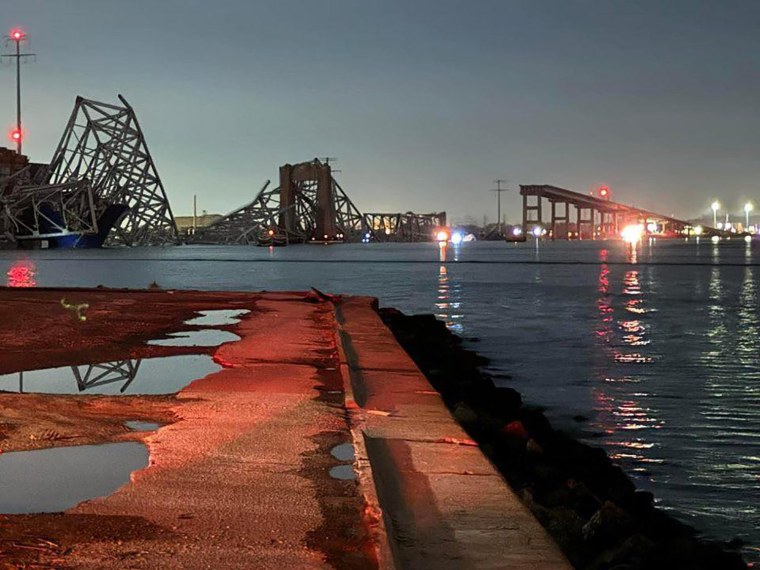
Bobby Haines, who lives in Dundalk in Baltimore County, said he felt the impact of the bridge collapse from his house nearby.
"I woke up at 1:30 this morning and my house shook, and I was freaking out," he said. "I thought it was an earthquake, and to find out it was a bridge is really, really scary."
Families of bridge workers wait for updates
Earlier in the day, relatives of the construction crew waited for updates on their loved ones.
Marian Del Carmen Castellon told Telemundo her husband, Miguel Luna, 49, was working on the bridge.
“They only tell us that we have to wait and that they can’t give us information,” she said.
Castellon said she was "devastated, devastated because our heart is broken, because we don’t know how they have been rescued yet. We are just waiting for the news."
Luna's co-worker Jesús Campos said he felt crushed, too.
“It hurts my heart to see what is happening. We are human beings, and they are my folks,” he said.
Campos told The Baltimore Banner that the missing men are from El Salvador, Guatemala, Honduras and Mexico.
Active search and rescue ends
The Coast Guard said it was suspending the active search-and-rescue effort at 7:30 p.m. Tuesday.
"Coast Guard’s not going away, none of our partners are going away, but we’re just going to transition into a different phase," Gilreath said at a news conference.
Maryland State Police Superintendent Roland L. Butler, Jr., said it was moving to a recovery operation. Changing conditions have made it dangerous for divers, he said.
Butler pledged to "do our very best to recover those six missing people," but the conditions are difficult.
"If we look at how challenging it is at a simple motor vehicle crash to extract an individual, I'm sure we can all imagine how much harder it is to do it in inclement weather, when it's cold, under the water, with very limited to no visibility," he said.
"There's a tremendous amount of debris in the water," which can include sharp metal and other hazards, and that could take time, Butler said.
'A long road in front of us'
Built in 1977 and referred to locally as the Key Bridge, the structure was later named after the author of the American national anthem.
The bridge is more than 8,500 feet long, or 1.6 miles. Its main section spans 1,200 feet, and it was one of the longest continuous truss bridges in the world upon its completion, according to the National Steel Bridge Alliance .
About 31,000 vehicles a day use the bridge, which equals 11.3 million vehicles per year, according to the Maryland Transportation Authority.
The river and the Port of Baltimore are both key to the shipping industry on the East Coast, generating more than $3.3 billion a year and directly employing more than 15,000 people.
Asked what people in Baltimore can expect going forward, the state's transportation secretary said it is too early to tell.
"Obviously we reached out to a number of engineering companies, so obviously we have a long road in front of us," Wiedefeld said.
Julia Jester reported from Baltimore, Patrick Smith from London, Corky Siemaszko from New York and Phil Helsel from Los Angeles.
Julia Jester is a producer for NBC News based in Washington, D.C.
Patrick Smith is a London-based editor and reporter for NBC News Digital.
Phil Helsel is a reporter for NBC News.
Corky Siemaszko is a senior reporter for NBC News Digital.
Tugboats left before ship reached Baltimore bridge. They might have saved it.

As investigators work to determine what caused the hulking Dali container ship to topple Baltimore’s Francis Scott Key bridge in a matter of seconds on Tuesday, maritime experts around the country are pointing to what could have stopped it.
These small but mighty vessels tow and push ever-larger ships through channels and help them when their propulsion systems – or lack thereof – cannot. They are standard equipment in ports worldwide and are especially useful to help ships with docking and undocking.
On Tuesday, a pair of tugboats operated by McAllister Towing and Transportation did just that, helping the Dali unmoor itself from the main terminal at the Port of Baltimore and orient the ship toward the open waters.
But they broke away before the massive ship navigated under the bridge , as is common practice. Minutes later, the Dali appeared to lose power and propulsion, sending the craft adrift and directly into one of the bridge’s support columns. The steel-truss bridge immediately collapsed into the frigid Patapsco River.
The accident is igniting debate over the proliferation of “megaships” that fuel today’s commercial transportation industry and whether port protocols have ramped up to safely accommodate them. Although the Dali is average-sized compared to many of these behemoths, the devastation it caused in Baltimore was formidable.
Live updates: Two bodies in Baltimore bridge collapse recovered; search for 4 others ends
Had the tugboats accompanied the ship all the way under the bridge, some experts said, they might have been able to stop, slow, or steer it away from danger.
Such a scenario should be standard operating procedure in all ports, said Capt. Ashok Pandey, a master mariner and associate professor of maritime business at the Massachusetts Maritime Academy. But he said the industry’s reliance on tugs has waned over the years as technological advancements gave many ships the ability to maneuver through channels independently.
Technology is great, Pandey said, until it fails.
“We went wrong by simply equipping ships with bow and stern thrusters that we use in lieu of tugs to maneuver in and out of the ports,” Pandey said. “When we are getting into ports like Baltimore, within a few miles of the bridge, that's too important an asset that we must think of protecting it by all means possible. And we can do that. We can easily do that.”
It may be rare for a ship to lose power at such a high-stakes moment, but it clearly does happen, and he said tugboats could have averted catastrophe.
Implementing such a practice would require a significant investment for U.S. ports, which either own and operate their own tugboats or contract out for tug services. Those costs are then rolled into the ports’ fees charged to shipping companies who use their facilities.
“There are a finite number of tugs, and 99.9% of the time there are no issues,” said Sal Mercogliano, a former merchant mariner and current maritime historian at Campbell University who also hosts a YouTube show called “What’s Going On With Shipping?”
“If the port required tug escorts in and out, then they would not be able to help other ships dock, and undock,” Mercogliano said. “It would need more tugs, and the question becomes, how much will this cost, and will it be passed on to the consumer?”
Because ports compete with each other for shipping business, he said, it’s unlikely that one port would mandate tug escorts unless all of the ports did it for fear of losing lucrative contracts. Shipping companies want the most efficient and cost-effective deal and will simply move to the next port if confronted with higher costs or longer waits.
Mercogliano said he’s not even sure tugboats would have been able to stop the Dali from hitting the bridge. When its power appeared to fail, the ship was going about 8 knots – roughly 9 mph – with a weight of over 100,000 tons.
“It would be like a Prius trying to move a Mack truck on the highway,” he said.
Realities of the container ship arms race
The Dali isn’t even big compared to other container ships hauling goods from port to port these days.
Over the past several decades, newly constructed ships have ballooned to gigantic proportions with load-carrying capacities that used to require five or six ships. The largest container vessel in the 1980s had a maximum capacity of 4,300 20-foot containers – otherwise referred to as TEUs, or 20-foot equivalent units – the standard unit of measurement for cargo capacity.
Today’s largest ship, the MSC Irina, has a capacity of 24,346 TEUs.
The Dali, by comparison, has a capacity of just under 10,000 TEUs, making it the typical “meat and potatoes of container ships,” said Kevin Calnan, assistant professor of marine transportation at California State University Maritime Academy.
Like most container ships, Calnan said, the Dali has one engine and one propeller. Its emergency diesel generator, standard in all such vessels, has enough power to keep key systems going – but not enough to restart the engine or provide propulsion.
In a video posted to social media, lights on the Dali shut off, then turned back on, then shut off again before the ship struck the bridge. Experts said that was likely the generator as it powered up the lights but not the engine.
It would have taken a second engine on board to fully power the ship and restore propulsion at that point. But Calnan said nobody in the commercial shipping industry is advocating for two engines because of their size and cost.
“Cargo is money, and companies want to maximize the amount of space they want to put cargo in, so to build a ship with a whole other engine would be taking up the space of, like, 150 containers on that ship,” he said. “Unfortunately, there’s not too much movement to require these ships to have two engines.”
Calnan, who has worked and sailed on numerous ships during his career, is among the experts who believe tugboats “definitely” could have stopped the Dali from hitting the bridge. He said he has been in similar situations where the power went out and “having tugs there basically saved the day.”
It may take a disaster for industry and ports to change
The bigger the boats and the more sophisticated the technology, the fewer the crew members on board. The Dali's crew is 22-strong.
In his 26 years sailing on commercial ships, Capt. Mike Campbell said he witnessed that shift to smaller crews as automation and electronics made it possible to do more with less when it came to docking, navigating and maintaining the engines.
“I had captains who would turn the radar off in the middle of the day because they didn't want to wear it out, and you'd just go off visual cues, take readings off lighthouses. Now everything is chips and boards,” he said. “And people are more dependent or reliant on it because they are more reliable.”
Campbell, now a professor at the Massachusetts Maritime Academy and master of the training ship Kennedy, said he’s also seen captains push to meet tight schedules, recalling a time when several other chemical carriers owned by competitors sailed out of the Port of Philadelphia into bad weather. His ship stayed put for three days, and arrived in Houston, safely, a day behind schedule. The other ships, he said, all had to sail to shipyards for repairs caused by the storm.
“I was fortunate that the people I sailed under, my mentors, they never worried about the schedule. It was always about the safe operation of the ship,” he said. “You don't want to push things.”
Mariners are always worried about their schedules now, Pandey said.
The shipping industry has become so highly competitive, with companies all vying for a slice of the business, that crews are more likely to leave port without containers than wait on a late shipment and risk falling behind. Ships typically go from port to port, spending anywhere from six to eight hours in each before moving on to the next.
He called it a race to nowhere in which everyone – from the ports to the shipping companies – is playing along.
U.S. ports have spent billions of dollars over the years adapting to the new reality – upgrading their facilities and dredging their channels deep enough to accommodate these massive ships. Some experts warn they could get even bigger in the future, possibly doubling in cargo capacity at some point.
Amid the race to compete for the revenue and jobs brought by these ever-larger ships, port authorities seem to have forgotten about protecting their critical infrastructure, according to Pandley, the former master mariner. He said Tuesday’s accident might be the wake-up call they need to do some real soul-searching.
USA TODAY reached out to the American Association of Port Authorities to ask its thoughts on requiring tug escorts or any other measures to avert the kind of disaster that happened in Baltimore, but a spokesman said nobody was immediately available to take those questions.
Unfortunately, experts said, it often takes a tragedy to improve an industry.
That’s what happened after the 1989 Exxon-Valdez oil spill in Alaska when the U.S. government required double-hull construction for all newly built oil tank ships and all oil tank barges in American waters. California passed a law in the aftermath of that disaster, requiring all oil tankers to have tug escorts in its ports and harbors.
“We have a saying that the laws are written in blood,” said Roland Rexha, international secretary-treasurer of the Marine Engineers’ Beneficial Association, the oldest maritime union in the United States.
“Knowing what we know now, could we have had tugs accompany the ship to the bridge? Sure. But what were the issues that caused the vessel to lose power in the first place?” he said. “There will be an investigation, and we’re hopeful that the lessons learned will lead to an active change in how things are operated.”
Advertisement
Supported by
The Five Minutes That Brought Down the Francis Scott Key Bridge
When a massive cargo ship lost power in Baltimore, crews scrambled to control the ship and to evacuate the bridge lying ahead. But it was too late.
- Share full article

By Annie Correal , Nicholas Bogel-Burroughs , Campbell Robertson , Michael Forsythe and Mike Baker
Nicholas Bogel-Burroughs and Campbell Robertson reported from Baltimore, Annie Correal and Michael Forsythe from New York, and Mike Baker from Seattle.
Follow our live coverage of the Francis Scott Key Bridge collapse in Baltimore .
“Hold all traffic on the Key Bridge.”
The terse command from an officer in Baltimore’s busy commercial shipping port was one of the first warnings of a disaster that experts now predict will transform shipping on the Eastern Seaboard and change how ships and bridges function around the world. But after the cargo ship Dali lost power early Tuesday, there were precious few minutes to act.
In those minutes, many people — from the ship’s crew, who sent out a mayday signal, to the transportation authority police officers, who stopped traffic heading onto the Francis Scott Key Bridge — did what they could to avert catastrophe, most likely saving many lives.
And yet — no matter what anyone did — several factors made catastrophe all but inevitable. When a ship of this size loses engine power, there is little to be done to correct its course, even dropping an anchor down. And the Key Bridge was particularly vulnerable. As long ago as 1980, engineers had warned that the bridge, because of its design, would never be able to survive a direct hit from a container ship.
The collision and subsequent collapse of the bridge swallowed up seven road workers and an inspector who could not be alerted and pulled off the bridge in time; two were pulled alive out of the water, but four others are still missing and presumed dead. Two bodies were retrieved on Wednesday, authorities said.
Also caught up in the disaster were the ship’s 21 crew members, all from India, who had prepared for a long journey to Sri Lanka on the Dali. While none of them were hurt, they would be held on board for more than a day as the ship sat in the harbor, the ruins of the bridge tangled around it, as authorities began their investigation.
The accident, the deadliest bridge collapse in the United States in more than a decade, will have a lasting impact on the Port of Baltimore, with its 8,000 workers, and industries that rely on the port, which is the leading American hub for auto and other wheeled equipment, said Pete Buttigieg, the U.S. transportation secretary, on Wednesday.
“It’s difficult to overstate the impact of this collision,” Mr. Buttigieg said.
He compared the Dali, roughly as long a city block, to the size of an American aircraft carrier.
“A hundred thousand tons, all going into this pier all at once,” he said of the impact on the bridge support structure.
Officials from the National Transportation Safety Board, which is leading the investigation into the accident, boarded the Dali on Tuesday night to gather documentation. They obtained data from the voyage data recorder, the equivalent of an aircraft’s black box, hoping that it could help investigators determine what led to the accident.
Mr. Buttigieg said that any private party found liable in the accident “will be held responsible.”
The ship left the Port
of Baltimore around
1 a.m. on Tuesday.
Ship called for
tugboats to return
Francis Scott
Alarms sounded on ship
Traffic onto bridge was halted
The ship hit
at 1:28 a.m.
Alarms sounded
Traffic onto bridge
Sources: MarineTraffic, Google Earth
By Agnes Chang, Weiyi Cai, and Leanne Abraham
It was about half an hour past midnight on Tuesday when the Dali, loaded with cargo containers, departed its dock, guided by two tugboats, as is customary. On board was a local harbor pilot with more than 10 years of experience and deep familiarity with Baltimore’s port, as well as an apprentice pilot in training.
The sky above the Patapsco River was clear and still, lit by a full moon.
At 1:25 a.m., after the two tugboats detached and turned back, the Dali had accelerated to about 10 miles per hour as it approached the Key Bridge. But just then, according to a timeline released by the National Transportation Safety Board on Wednesday, “numerous audible alarms” started sounding on the ship.
For reasons still being investigated, the ship’s powerful propulsion system stopped. The lights flickered out.
The ship had a “complete blackout,” according to Clay Diamond, head of the American Pilots’ Association, who was briefed on the account of the pilot of the Dali. (The chair of the N.T.S.B., Jennifer Homendy, said officials were still trying to determine whether the power failure was complete.)
The harbor pilot noticed the ship starting to swing right, in the direction of one of the piers holding up the Key Bridge. At 1:26, he called for the tugs to return; he urged the captain to try to get the engine back up and directed the crew to steer hard left. As a last ditch measure, at 1:27, he ordered the crew to throw down the port anchor.
One of the tugboats, the Eric McAllister, turned around and raced back toward the ship.
But the failures onboard were cascading. The emergency generator had kicked on, sending a puff of thick smoke belching from the ship’s exhaust stack and briefly restoring the lights, radar and steering. It did not help. With no effective propulsion, the 95,000-ton ship had become an unstoppable object, drifting toward one of the most heavily traveled bridges in Baltimore.
On land, officers with the Maryland Transportation Authority moved swiftly into action. “I need one of you guys on the South side, one of you guys on the North side, hold all traffic on the Key Bridge,” someone is heard saying on the audio recording of emergency radio traffic that night. “There’s a ship approaching that just lost their steering. So until they get that under control, we’ve got to stop all traffic.”
Vehicles were held on either side of the bridge as the ship continued its inexorable drift toward the 1.6-mile-long span.
A minute later, the officers turned their attention to several workers, some of them immigrants from Guatemala, Honduras, El Salvador and Mexico, who were still laboring on the bridge in the chilly darkness, taking advantage of the light traffic at night to fix potholes.
“There’s a crew up there,” one officer is heard saying on the audio recording of the radio exchange between officers. “You might want to notify whoever the foreman is, see if we could get them off the bridge temporarily.”
But even then, the ship was striking the bridge. Almost at once, the pier buckled and collapsed, twisting over the ship, with its cargo containers stacked high on the deck. Then the rest of the bridge went, breaking into sections as it plummeted and splashed into the dark river waters below.
“The size and weight of these ships make them really difficult, even with propulsion, to stop them,” said Stash Pelkowski, a professor at State University of New York Maritime College and a retired Coast Guard rear admiral. With no power, he said, “There was very little the pilot or the crew on the Dali could do.”
The collapse had happened in seconds. Except for the stumps of the piers, the central span of the bridge had plunged into the frigid river — where divers would spend the whole day searching amid twisted metal for survivors — by 1:29 a.m.
“Dispatch, the whole bridge just fell down!” an officer called out. “Whoever, everybody, the whole bridge just collapsed.”
Stray ships had long been seen as a risk to the Key Bridge. Just a few years after the Baltimore structure was constructed in 1977, a vessel crash knocked down the Sunshine Skyway Bridge in Tampa Bay, Fla., killing 35 people.
Officials acknowledged that the Key Bridge would not be able to withstand that kind of direct hit from a heavy cargo vessel. “I would have to say if that ship hit the Bay Bridge or the Key Bridge — I’m talking about the main supports, a direct hit — it would knock it down,” John Snyder, the director of engineering for the state Toll Facilities Administration told the Baltimore Sun at the time.
But building a bridge that could withstand such an impact was simply not economically feasible, he said. When the bridge was built, cargo ships were not the size they are today. A much smaller freighter did hit the bridge in 1980 , but the bridge stood strong.
Minutes after the bridge collapsed on Tuesday, both tugboats that had accompanied the Dali arrived on scene, followed soon by the Coast Guard and the Baltimore City Fire Department.
Two of the workers who had been on the bridge were rescued from the water. The others could not be found.
Jack Murphy, who owns Brawner Builders, the company whose workers had been on the bridge, got a phone call about the collapse and raced to the area, about a 30-minute drive away. He stayed by the bridge all night, and eventually began making calls to the men’s families.
Two workers’ bodies were discovered in a red pickup truck found near the bridge debris, police said Wednesday. They were identified as Alejandro Hernandez Fuentes, 35, an immigrant from Mexico, and Dorlian Ronial Castillo Cabrera, 26, a native of Guatemala.
About two miles from the bridge, Andrew Middleton had been lying awake when he heard the crash. He first thought it was thunder, maybe a low-flying jet.
It was only when he awoke a few hours later that he saw the news of the collapsed bridge. “I thought to myself, I was just with those guys yesterday,” he said.
Mr. Middleton, who runs Apostleship of the Sea, a program that ministers to sailors coming through the port, had driven the ship’s captain and a few crew members to Walmart on Monday to stock up on goods for the 28-day voyage ahead — toothpaste, snacks, clothes, Bluetooth speakers.
He recalled the captain telling him their next port was Sri Lanka, but that they were taking a longer route, down around South Africa, in order to avoid recent Houthi attacks on cargo ships in the Red Sea.
Mr. Middleton immediately messaged the crew on WhatsApp after hearing the news on Tuesday, he said, and “they responded within a few minutes saying that everyone was OK,” he said.
Around the site of the bridge collapse, firefighters and rescuers in diving gear were swarming around the shore, followed by news crews. John McAvoy, who owns a nearby restaurant, had driven over with hot meals — chicken, crab balls and pretzel bites — to hand out to the crews.
But by nightfall on Tuesday, officials had called off the rescue efforts and said they would switch to searching for bodies. “The water’s deep, visibility’s low, it’s cold as I-don’t-know-what,” said Kevin Cartwright, a spokesman for the Fire Department.
The signs of all that had changed were only starting to become clear on Wednesday. The U.S. Army Corps of Engineers said it was mobilizing more than 1,100 specialists to clear the wreckage of the bridge and unblock the Port of Baltimore’s shipping lane. In the meantime, Mr. Buttigieg, the secretary of transportation, said the East Coast would have to rely more heavily on ports outside Baltimore.
Mr. McAvoy said the tragedy would ripple over the port for years.
Fishing crews always have found their way home following the Key Bridge, he said. “It’s going to change a lot of things for a lot of people.”
Reporting was contributed by Daniel Victor , Jacey Fortin , Zach Montague , Eduardo Medina , Miriam Jordan and Judson Jones . Susan C. Beachy contributed research.
Annie Correal reports from the U.S. and Latin America for The Times. More about Annie Correal
Nicholas Bogel-Burroughs reports on national stories across the United States with a focus on criminal justice. He is from upstate New York. More about Nicholas Bogel-Burroughs
Campbell Robertson reports on Delaware, the District Columbia, Kentucky, Maryland, Ohio, Pennsylvania and Virginia, for The Times. More about Campbell Robertson
Michael Forsythe a reporter on the investigations team at The Times, based in New York. He has written extensively about, and from, China. More about Michael Forsythe
Mike Baker is a national reporter for The Times, based in Seattle. More about Mike Baker

IMAGES
VIDEO
COMMENTS
As such a power boat, and by extension all sailboats, MUST, without question show one green light on the starboard bow and one red light on the port bow and one all around white light or lights while operating in reduced visibility. These lights should shine at all 360 degrees of visibility with the bow lights shining at an angle of dead ahead ...
The specific rules for a sailboat under sail are in COLREGS Rule 25 and vary slightly with the size of the boat. A sailboat powering is considered a power boat and falls under in Rule 23. Under 23 feet (7 meters) - side lights and a stern light, possible. If these lights can not be displayed a light must be kept at hand to help avoid a collision.
NOTE: Sailboats operating under engine power are considered power-driven and must follow the "Under Power" rules. Powerboats that are less than 12m (39.4') may substitute a single all-round light for separate stern and masthead lights. Powerboats and sailboats under power that are less than 20m (65.7') can substitute a single bi-color light ...
Here is a sailing vessel under sail using a tricolored light. There is no forward-facing white light, like in the upper picture, so we know it is under sail. To clarify, on a sailboat less than 50 meters in length, a white under power mast head light can be just up the mast anywhere. That is to say that it's not part of the tri color.
This includes sailing vessels under power and motor sailing. Boats larger than 12 meters but less than 20 meters (39-65 feet) have a 2 NM requirement for side lights, a 2 NM requirement for stern light and 3 NM requirement for masthead light. A sailboat under sail alone does not have the 3 NM requirement for the masthead light.
Red and green sidelights, one sternlight, and two all-round lights in a vertical line (upper red, lower green) also meet the navigation lights requirement for sailboats that are not operating under engine power (Rule 25). One combination red, green, and white light exhibited near the top of the mast meets the navigation lights requirement for ...
On any vessel, navigation lights have a specific color, (white, red, green, yellow, blue), arc of illumination, range of visibility, and location, as required by law and regulations. For the purposes of this course, we will concentrate on pleasure boats under 65 feet in length. Knowledge of navigation lights is important to a small-boat skipper ...
When flashing under normal conditions, it signifies repeated sound signals or a sailing boat under power. 3. Important Considerations: ... The Power of Masthead Light Lengths: Proper positioning of masthead lights provides vital information about a vessel's size during nighttime encounters at sea. Longer masts facilitate increased visibility ...
Power boats less than 20 meters shall exhibit navigation lights as shown in Figure 1. (Note: 2 masthead lights are optional for vessels under 50 meters. Vessels over 50 meters will display two masthead lights.) Figure 2. Vessels of less than 12 meters in length, may show the lights in either Figure 1 or Figure 2.
On a sailboat under 20 meters, all three lights can be combined in a tri-color light at the masthead, but only when sailing; under power, a sailboat must show a 360-degree circle of white light, either in an all-around light at the masthead, or in a combination of stern light plus a 225-degree masthead light.
Additionally, the all-around white light must be positioned at least 39 inches above the sidelights. Refer to Figure A as an example of the proper configuration. Note that sailboat in Figure E is using a motor. Even if a sailboat is flying its sail it may still be under engine power, in which case, it is treated as a powered vessel.
That means some additional lights to communicate the fact that it's currently under power with a steaming light. The reason has to do with the navigational rules. Usually, sailboats have the right-of-way over powerboats because they are wind-powered and have less control. ... Sailboat lights at night are a crucial part of safe navigating when ...
The most common steaming light is a single white light that shines forward of the mast in a 225-degree arc. Combined with the stern light, a boat under power will now be displaying a 360-degree white light in combination with its red and green lights. This sequence of lights should be used while MOTORING at night.
A steaming light is a white navigation light fitted on the mast of a sailboat to provide visibility during low-visibility conditions. It is typically placed near the front side of the mast and angled downwards to indicate that the vessel is under power and moving forward. This light helps other boats identify and avoid collisions, ensuring safe ...
The navigational lights used are known as 'COLREG lights and shapes. A boat might be anchored or underway, under sail or power, or fishing or trawling. These various situations can be communicated through multiple combinations of boat navigational lights. ... Two Steaming Lights: Power-driven vessels that span over 50 m or 160 ft in length ...
Rule 25(e) Sailboats - Under Power (Motorsailing): A sailboat, either fully or partially under power, for the purposes of the Rules of Navigation, is treated as a power driven vessel (powerboat). ... White Stern light. Navigation Lights - Power boat under 50m . Rule 23(d)(i)Power Boats underway - under 12 Meters: A power vessel less than ...
Required Lights: Sailboats When Underway. If less than 65.6 feet long, these vessels must exhibit the lights as shown in Figure 2. The required lights are: Red and green sidelights visible from a distance of at least two miles away—or if less than 39.4 feet long, at least one mile away—on a dark, clear night.
Running Lights. When under power: You must use your navigation and steaming lights (at left). When under sail: Use either your masthead tricolor (second to left) or deck-level navigation lights (second to right), but not both. At anchor: You must display a white light that's visible through 360 degrees (at right).
23 - Power driven vessels over 12m must have a forward-facing steaming light plus sidelights and a stern light below the level of the steaming light. 25 - Sailing vessels Underway shall exhibit sidelights (red/green) as either a combined or as separate lights, and a white stern light. 30 - Anchored Vessels under 50m shall exhibit an all-round ...
In video, as it navigates down the Patapsco River, the ship's lights can be seen going out at 1:24 a.m. ET, before turning back on, and then flickering off and on again between 1:26 a.m. ET and ...
The lights of the ship flickered on and off as it lost power in the minutes before the ship changed bearing and hit the bridge. 1:25 a.m.
Over the course of four minutes the lights on the ship went off and on, indicating that the power was going in and out. 01:24:22 a.m. Dali moves southeast toward Francis Scott Key Bridge
Normally the boats sail between 10:00 a.m. and 9:00 p.m. although there are also companies that offer night cruises with dinner included. I recommend that you take advantage of the afternoons for a boat tour, when the monuments and museums are closed. Going on a night cruise to see the Moscow city lights is also a very good option.
1.24am and 33 seconds: The ship appears to suffer a total power failure as all its lights go out. 1.25am and 31 seconds: About a minute later, the ship's lights flicker back on. Black smoke starts ...
The operators of the Dali cargo ship issued a mayday call moments before the crash early Tuesday saying the vessel had lost power. But the 985-foot-long (300-meter-long) ship still struck one of the 1.6-mile (2.6-kilometer) bridge's supports at 8 knots, which is roughly 9 mph (15 kph).
8 Presnenskaya Embankment, Bldg. 1. citymoscow.ru. Free. If there is a district of the city that never sleeps, it is definitely Moscow-City. At night, there is no daytime hustle and bustle and no hurrying office workers, but there are stunningly illuminated skyscrapers. When you get tired of admiring, go inside — on the 53rd floor of Imperia ...
At 1:24 a.m., it suffered a total power failure and all its lights went out. Three minutes later, at 1:27 a.m., the container ship struck a pylon of the bridge, crumpling almost the entire ...
Investigators said in a timeline that the Dali's lights suddenly shut off four minutes earlier before they came back on and that then, at 1:25 a.m. dark black smoke began billowing from the ship's ...
In a video posted to social media, lights on the Dali shut off, then turned back on, then shut off again before the ship struck the bridge. Experts said that was likely the generator as it powered ...
So until they get that under control, we've got to stop all traffic." Vehicles were held on either side of the bridge as the ship continued its inexorable drift toward the 1.6-mile-long span.